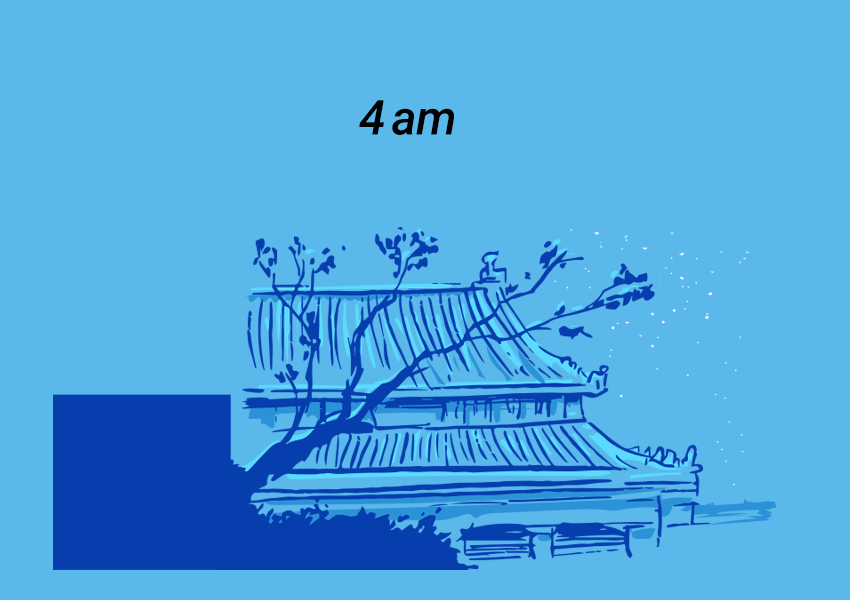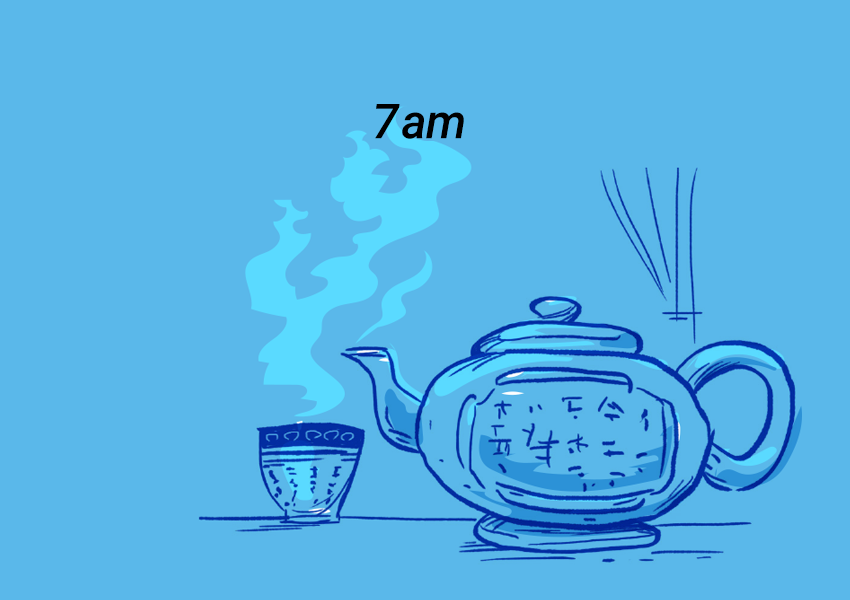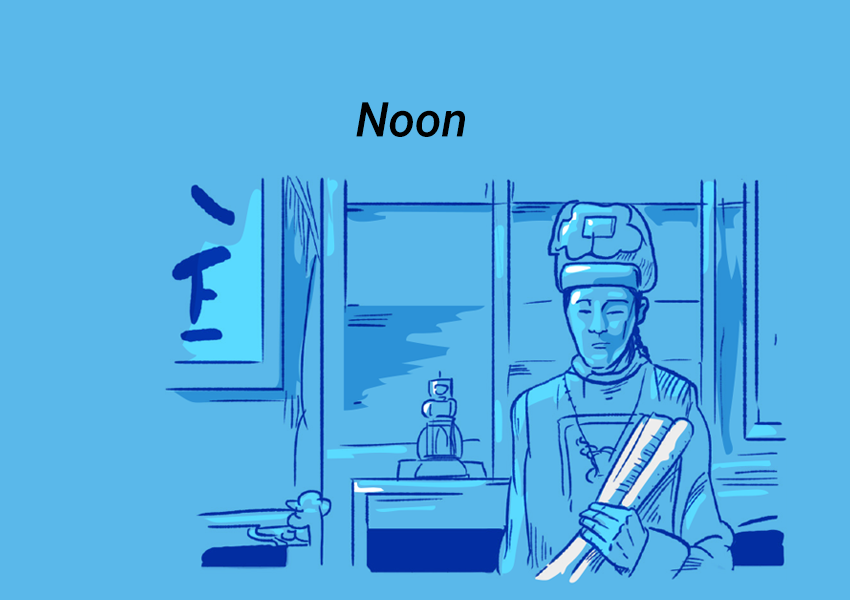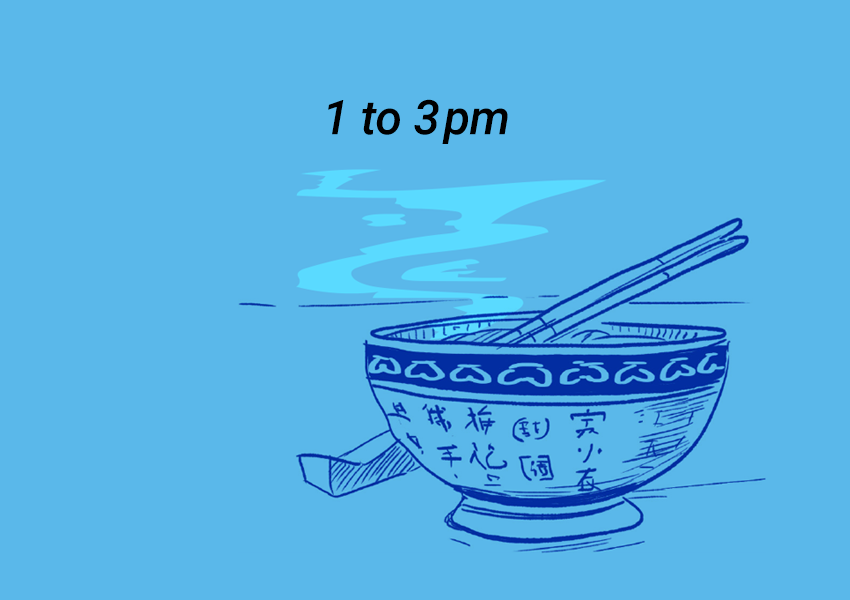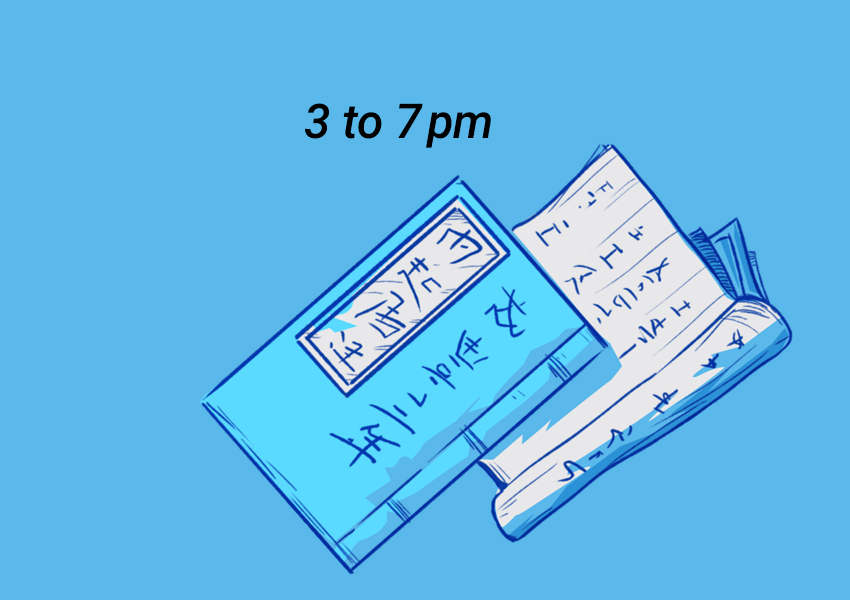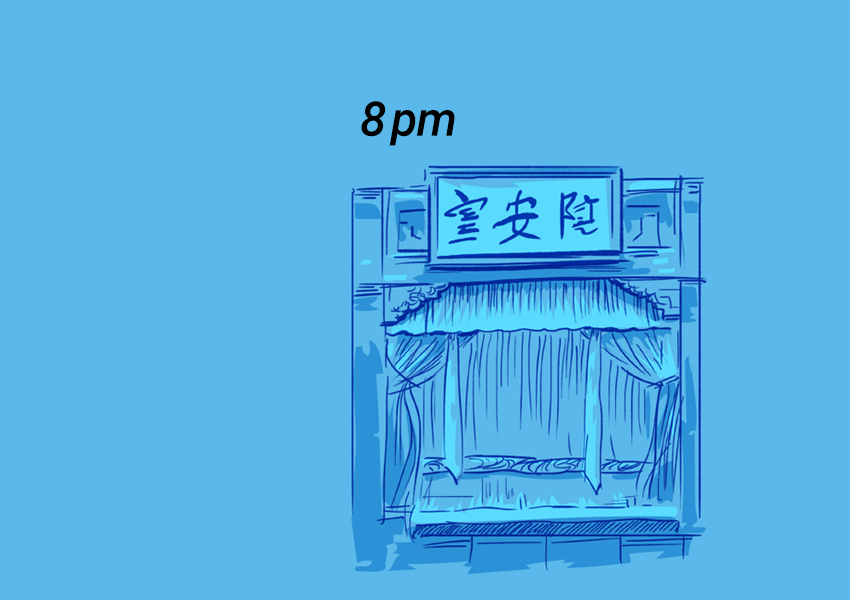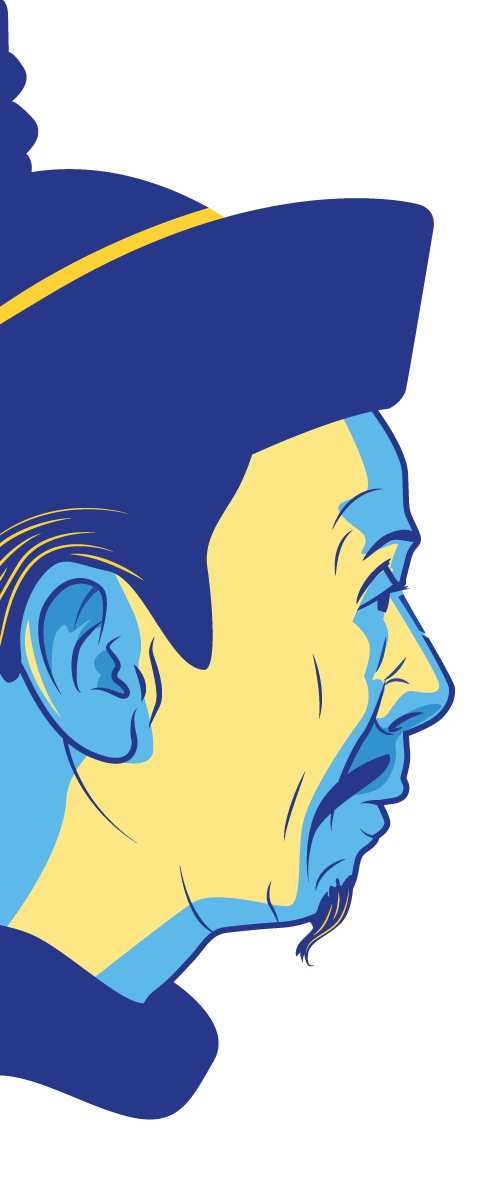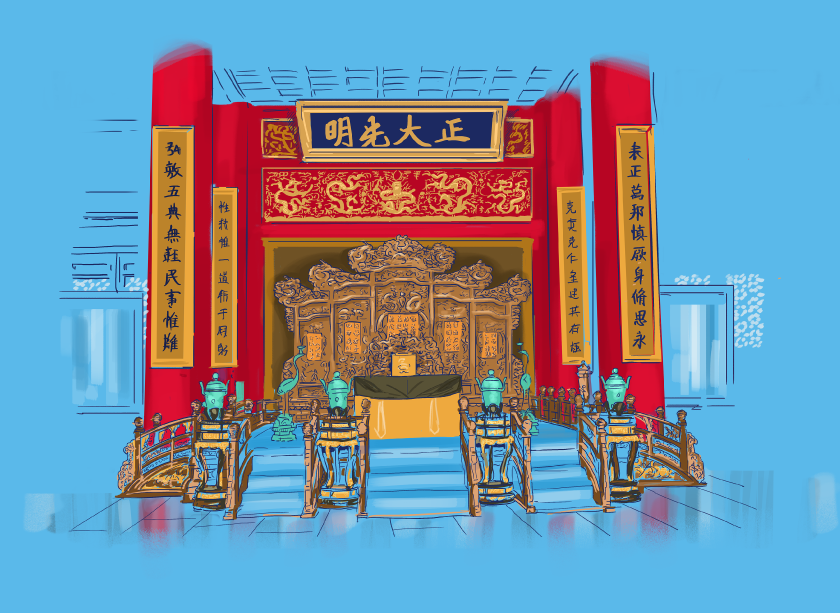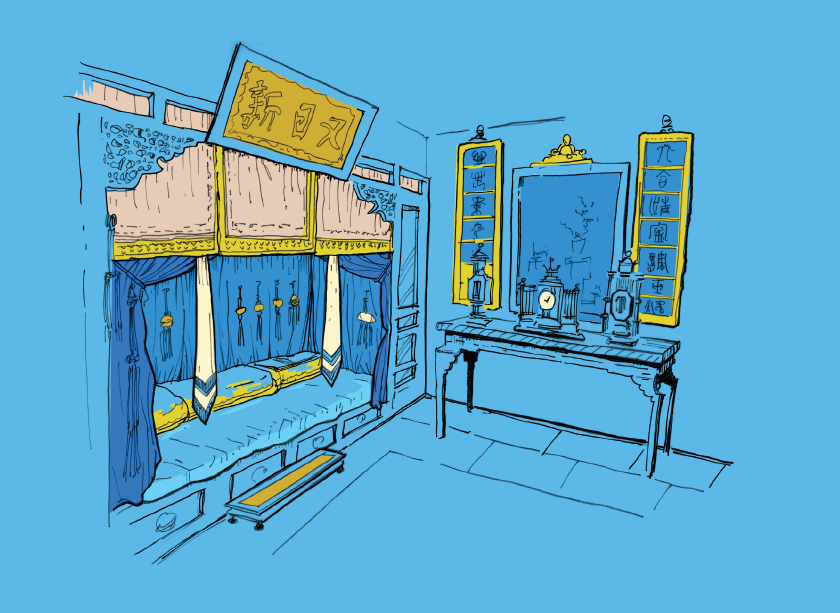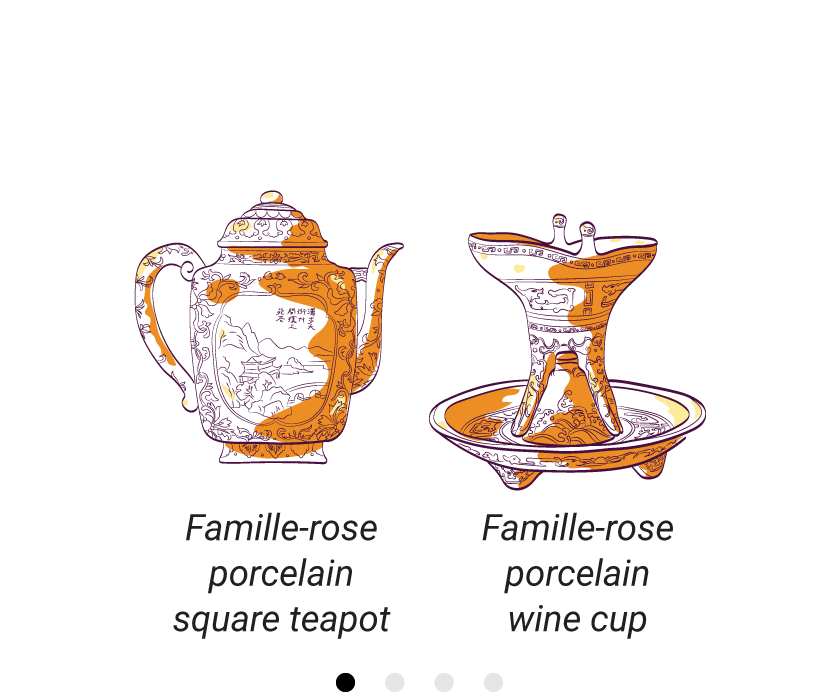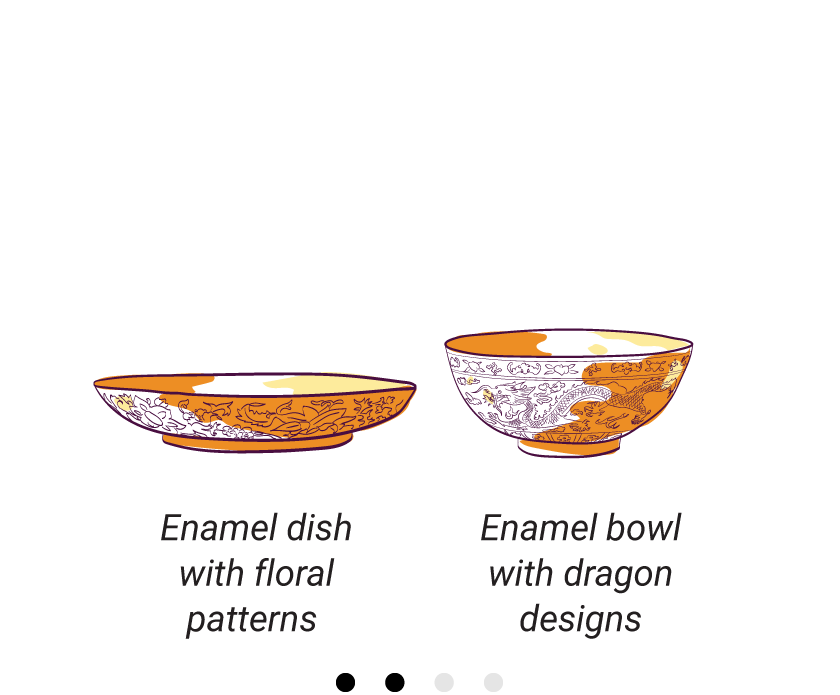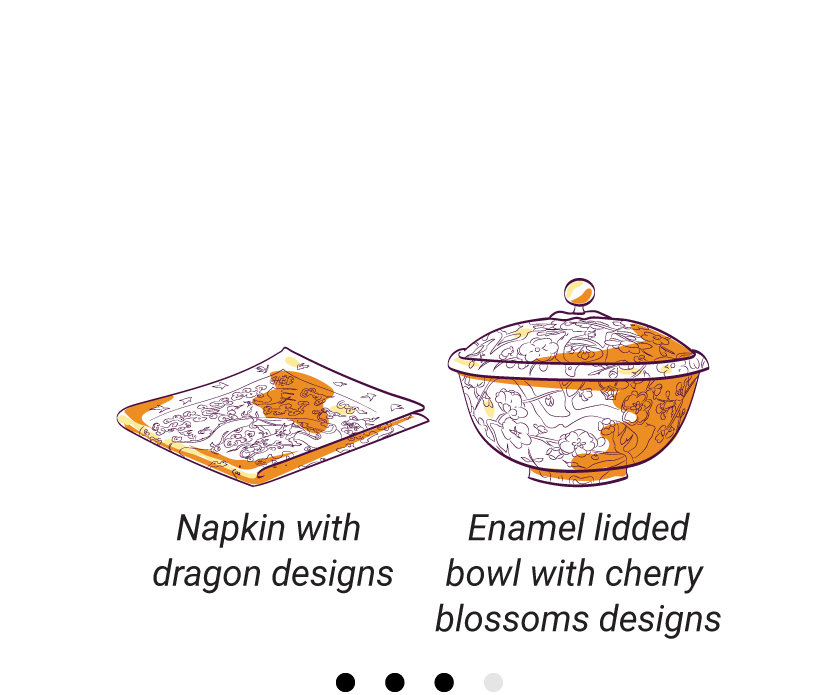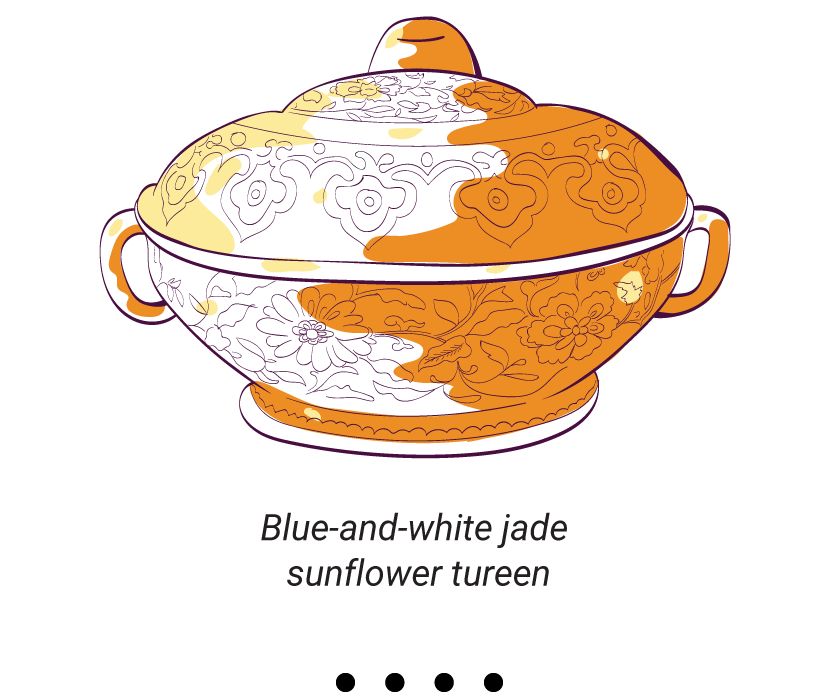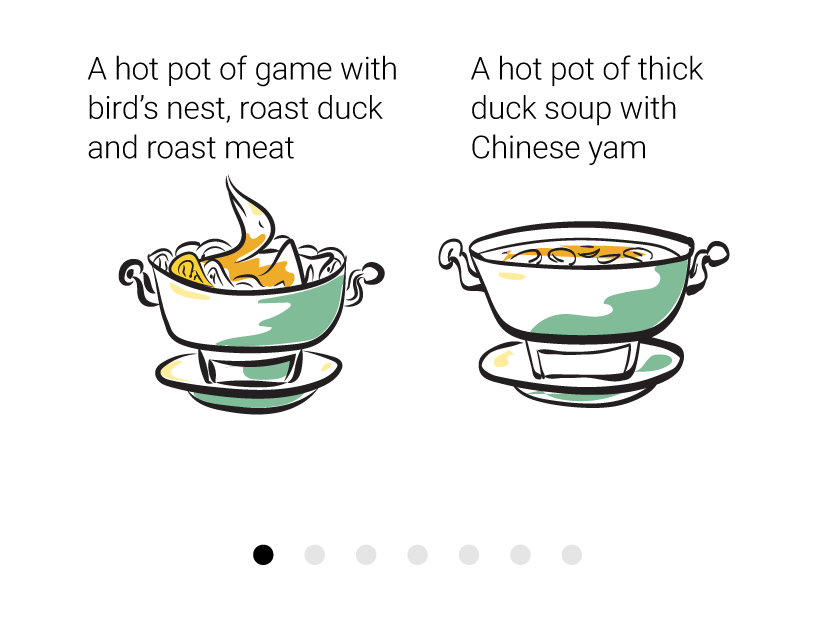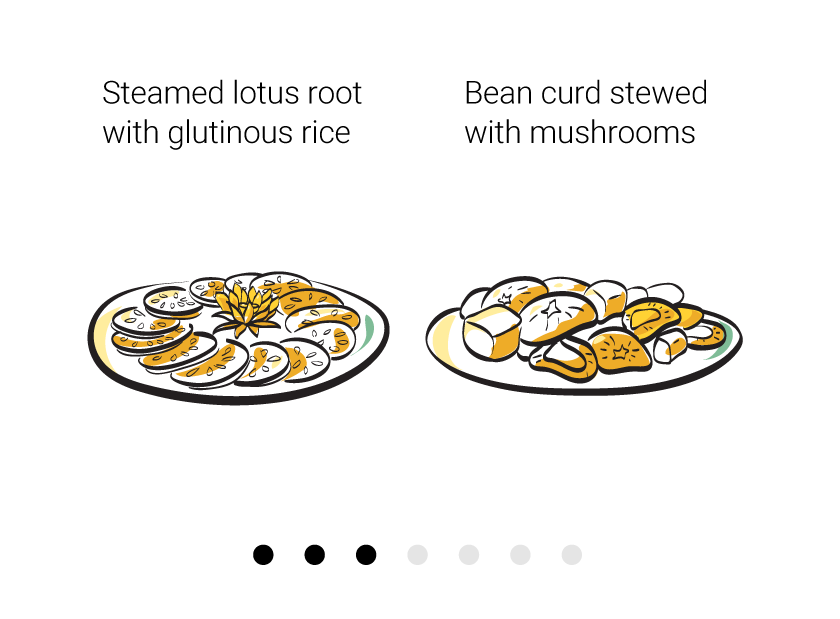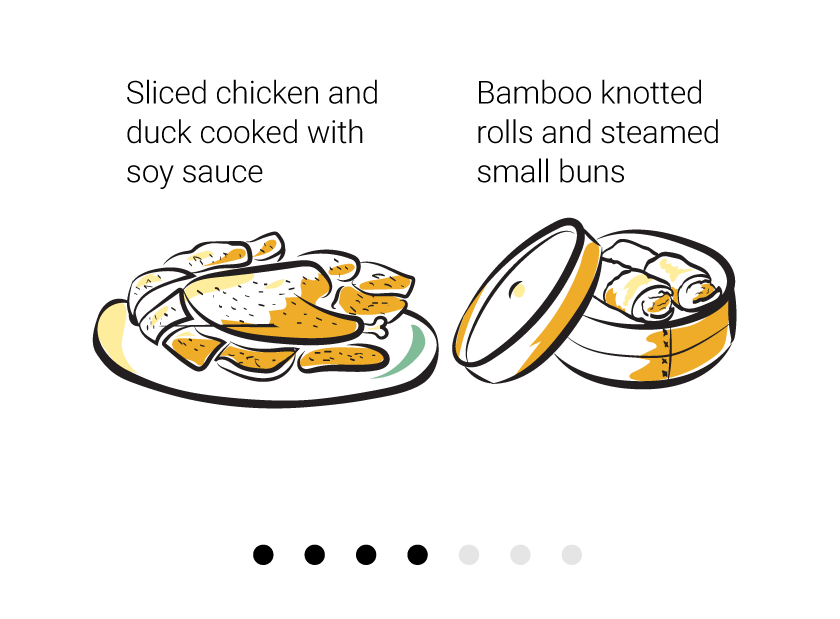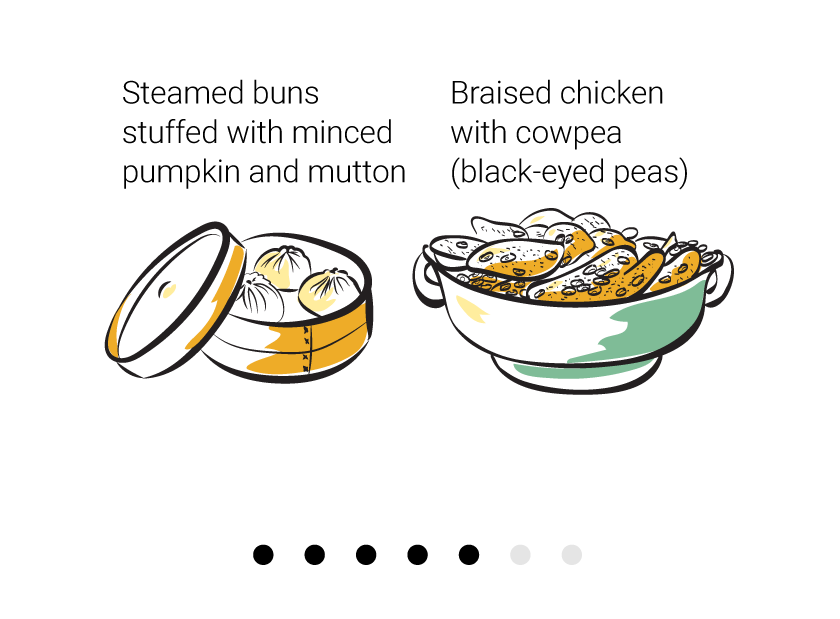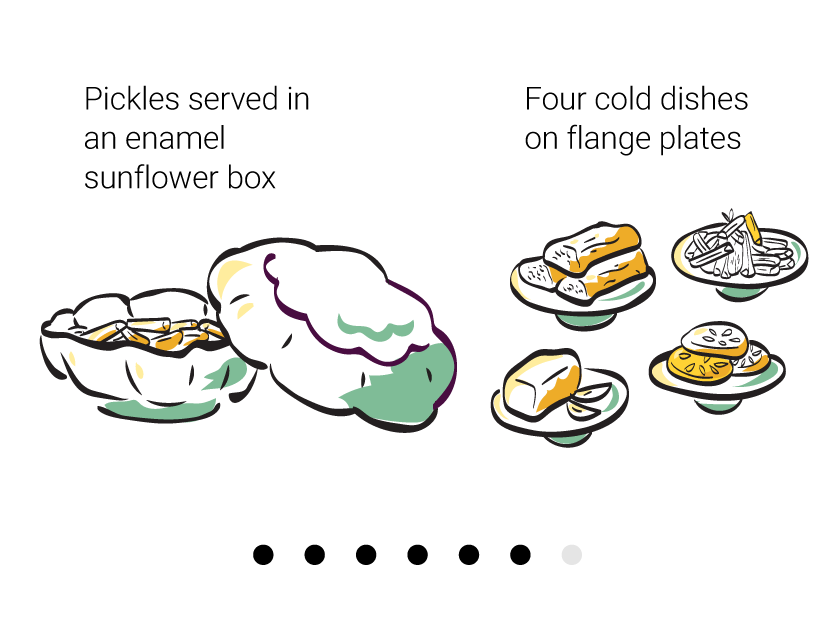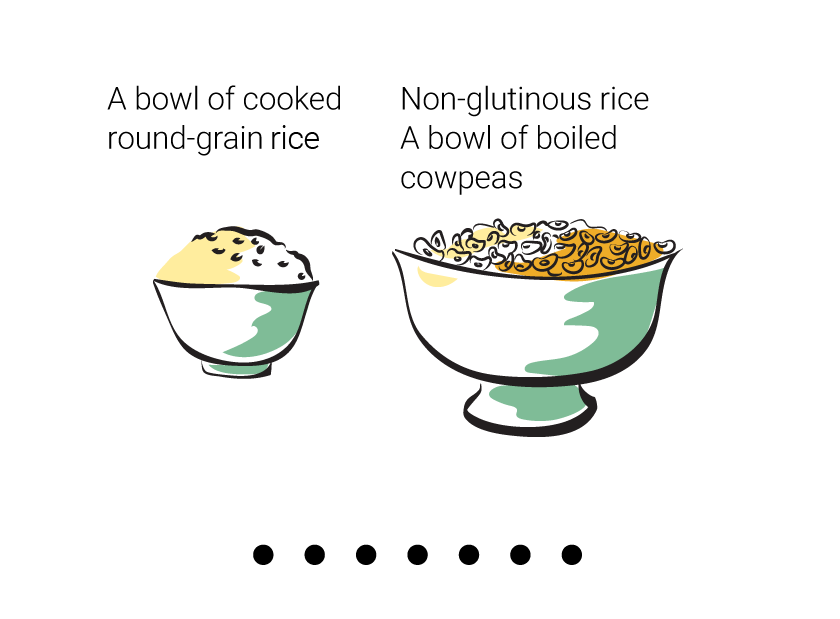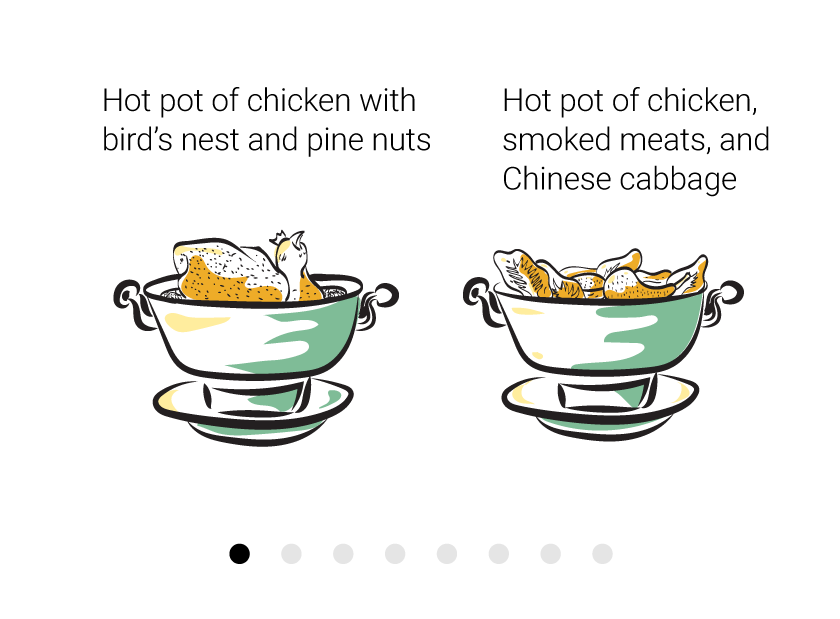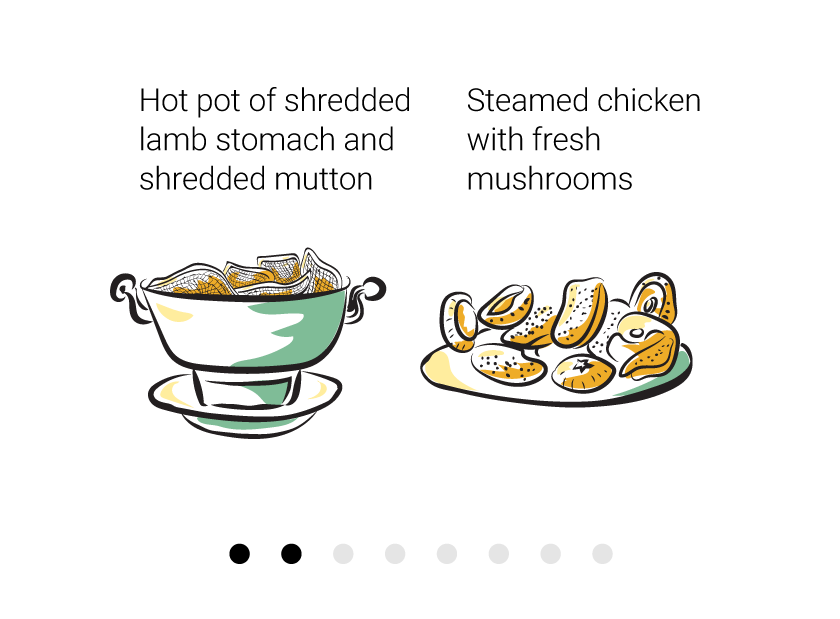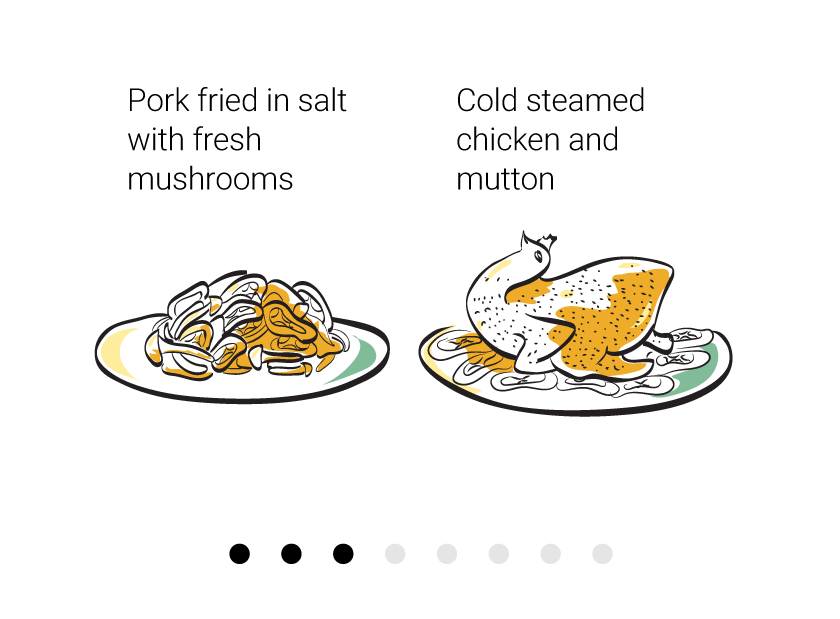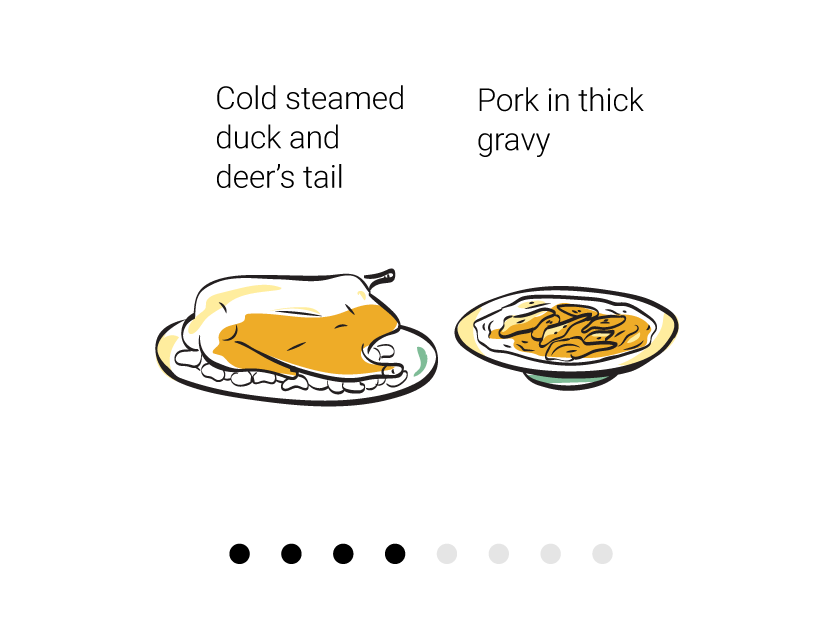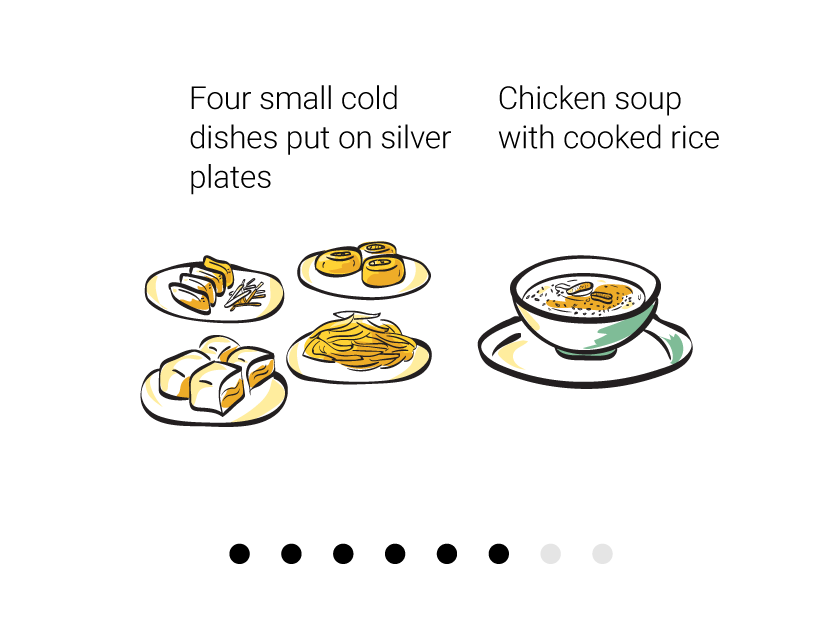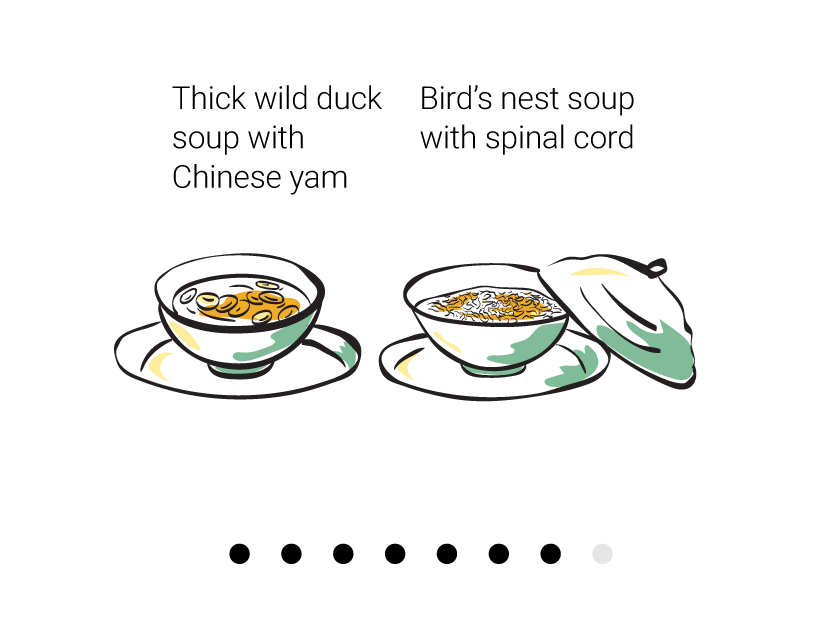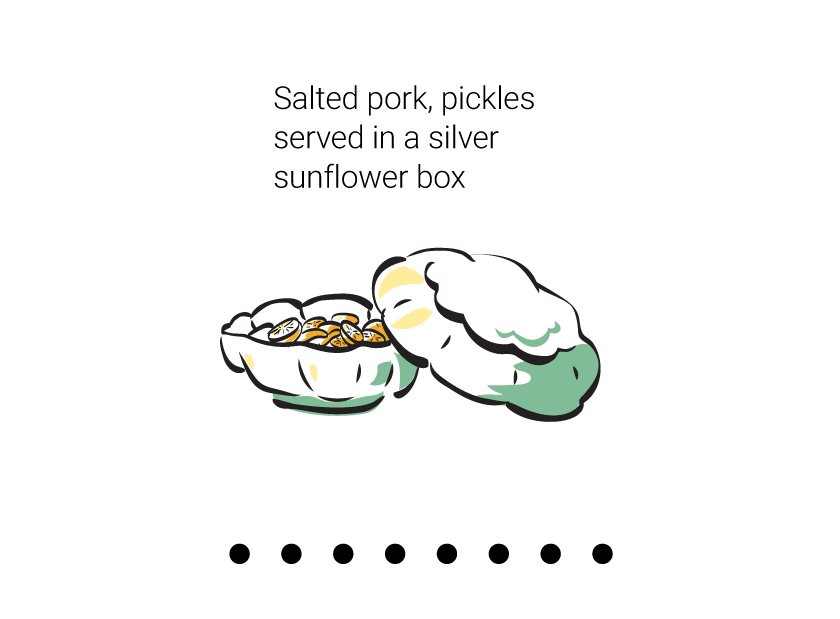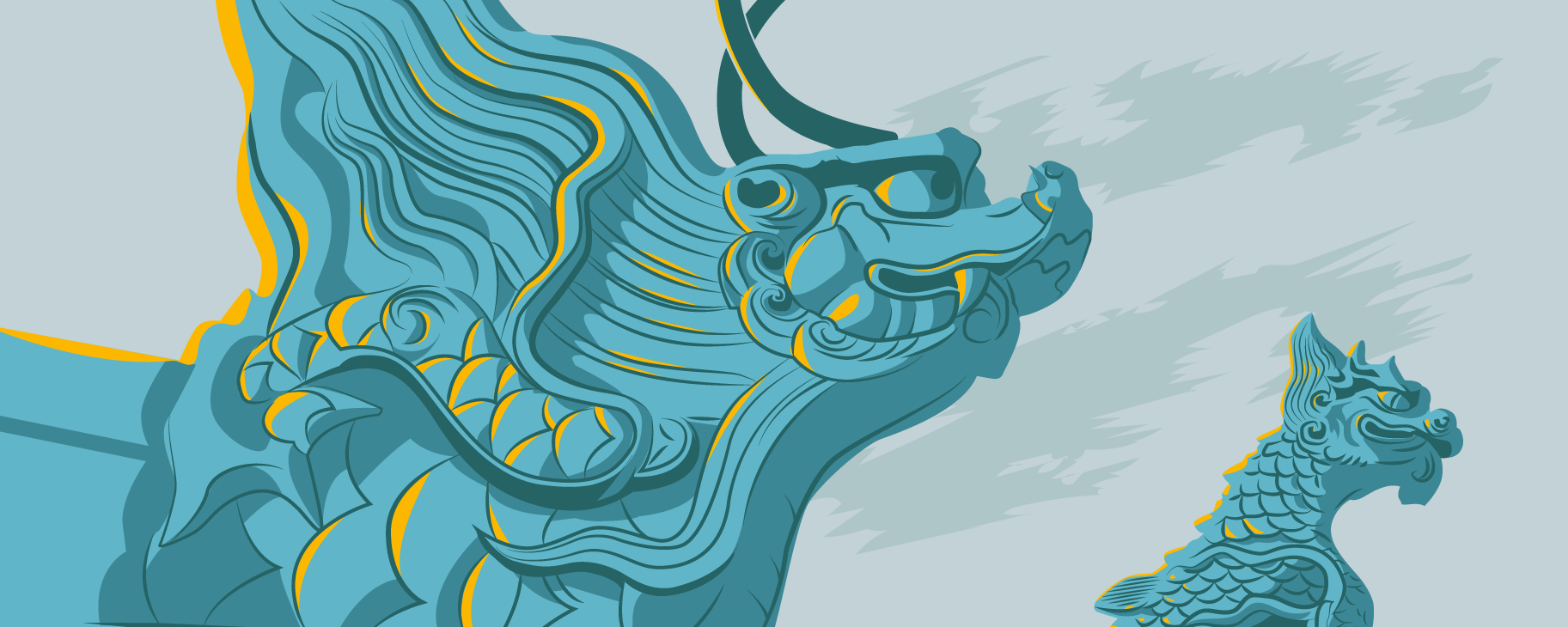
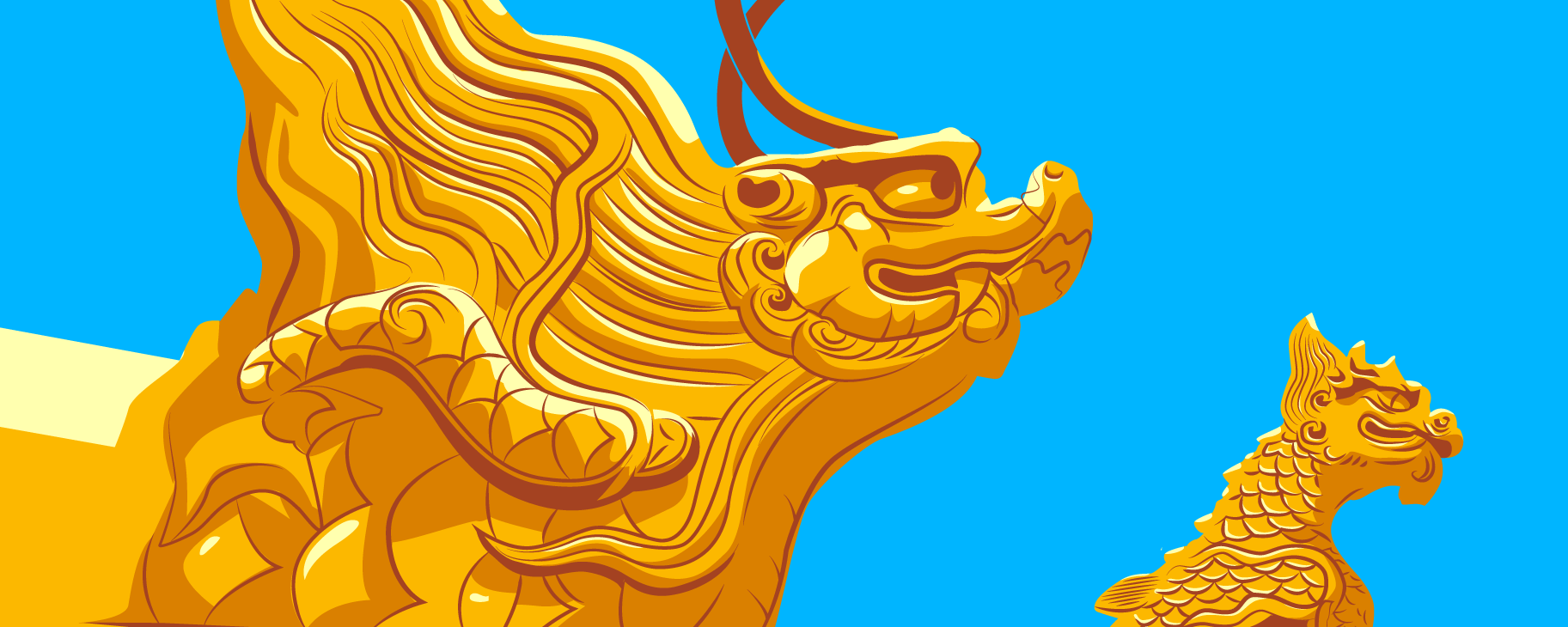
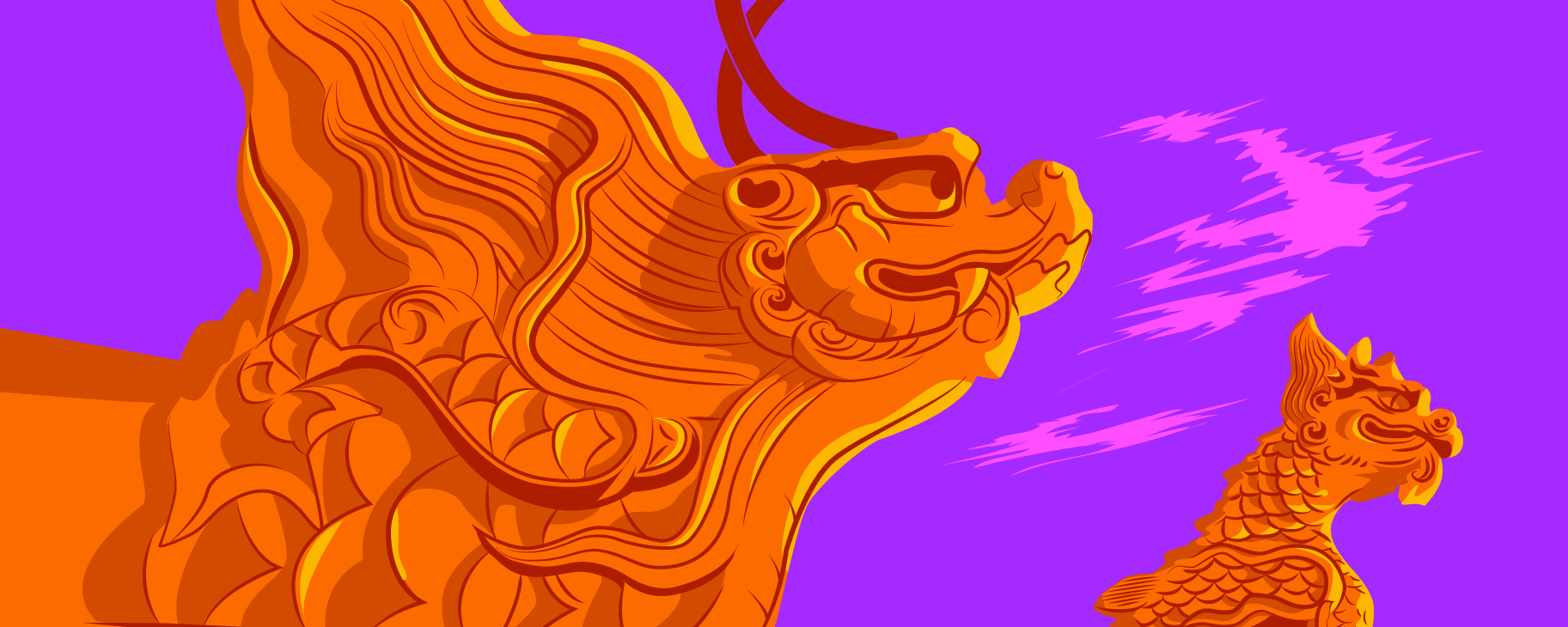
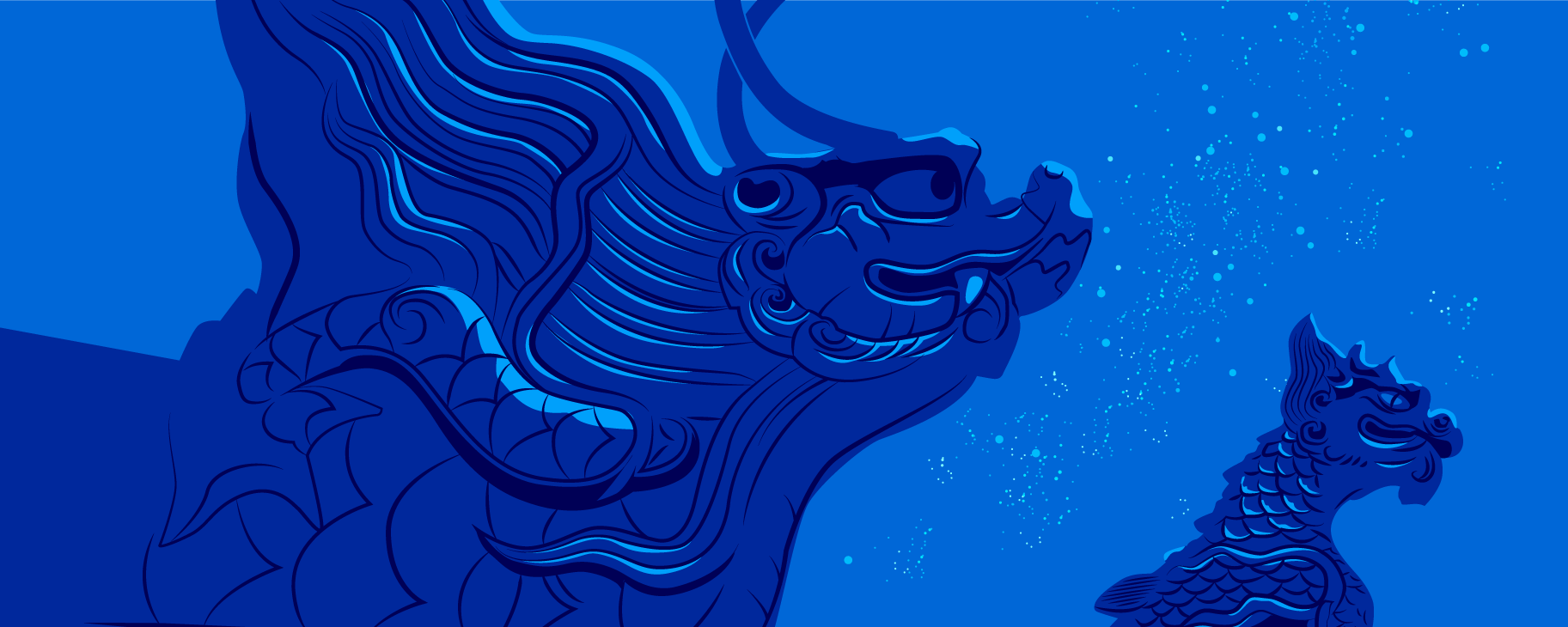
Life inside the Forbidden City
chapter 3
Why being a Chinese emperor didn’t always mean limitless power and pleasure
A PREVIOUS VERSION OF THIS GRAPHIC WAS PUBLISHED ON AUGUST 08, 2018. IT HAS BEEN UPDATED AND WAS REPUBLISHED ON OCTOBER 10, 2025.

Marcelo
Duhalde
For the emperor, life in the Forbidden City was not always as free and privileged as one might imagine. Despite being hailed as heaven’s representative, the emperor remained a link in a giant bureaucratic chain, compelled to follow rigorous protocols dictated by tradition.
The emperor's routine was anything but limitless pleasure. He was obliged to attend early morning meetings on matters of public interest, where he ruled on things such as appropriate punishments and executions. He also received a steady stream of delegates to discuss policies and sign edicts. To compound these pressures, the ruler’s routine was supervised by eunuchs and officials who did not always have his best interests at heart.
Daily duties
4am
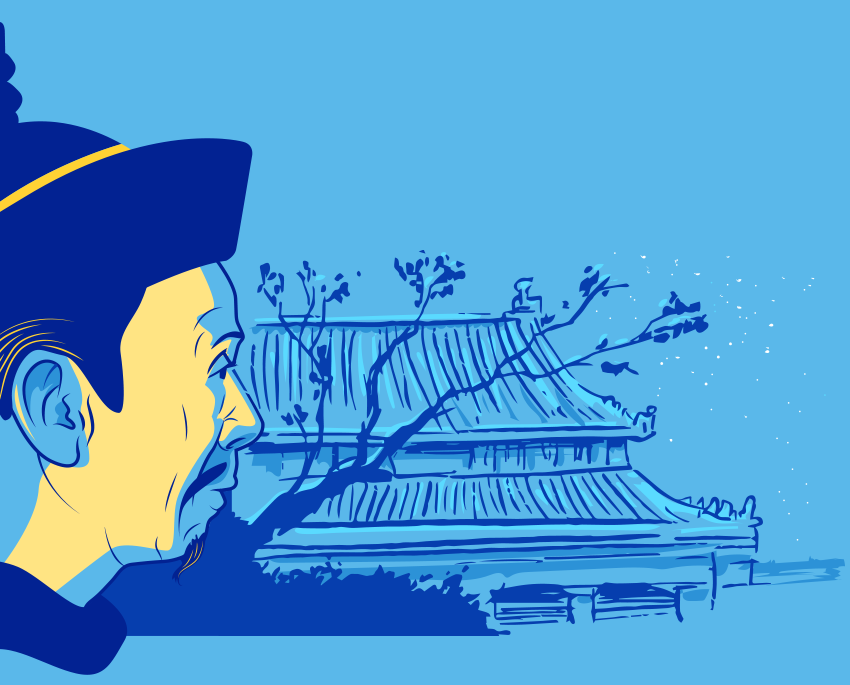
The emperor had to rise for ch’ing chia (“Your appearance is begged in court”) - the early audience with his courtiers. He then returned to his chamber to get a little more sleep.
7am
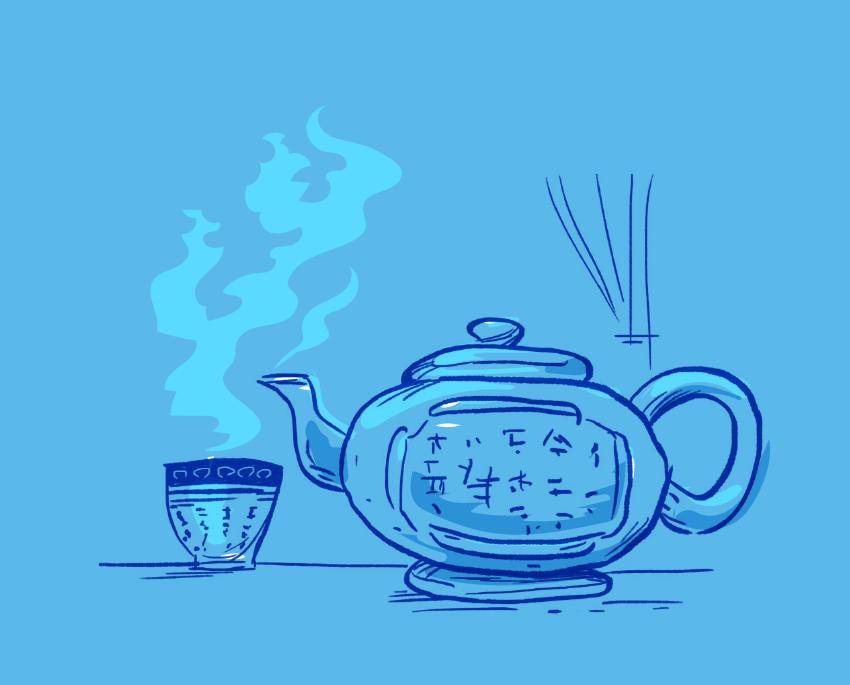
Breakfast was at 7am in spring and winter and 6am in summer and autumn. The emperor selected the name cards of officials from a plate prepared by eunuchs, then opened and read the initial memorials (reports) presented by his ministers.
Noon
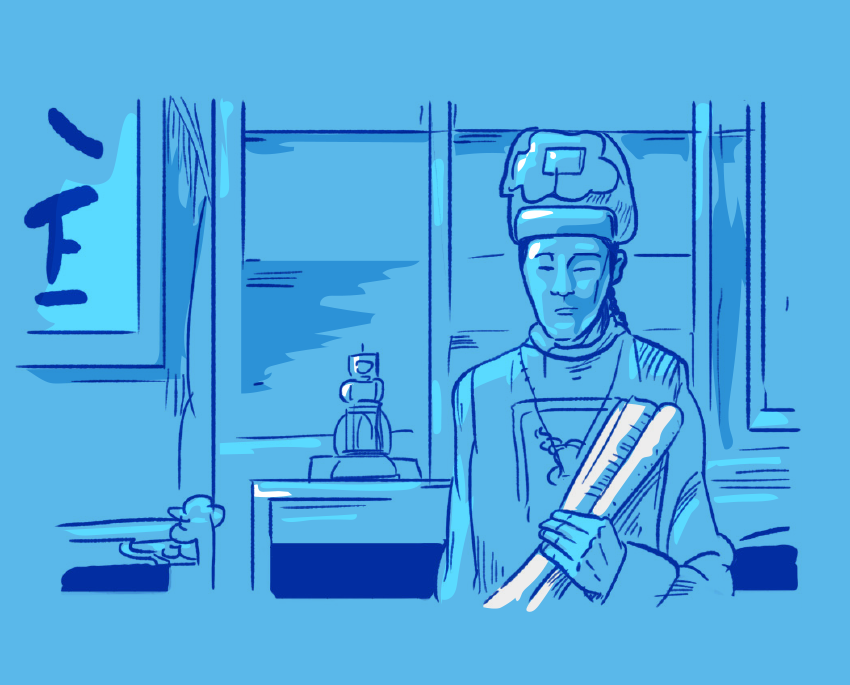
A second audience took place. His main duty was to read and write comments on the steady stream of more than 100 local government memorials received daily from across the empire.
1-3pm
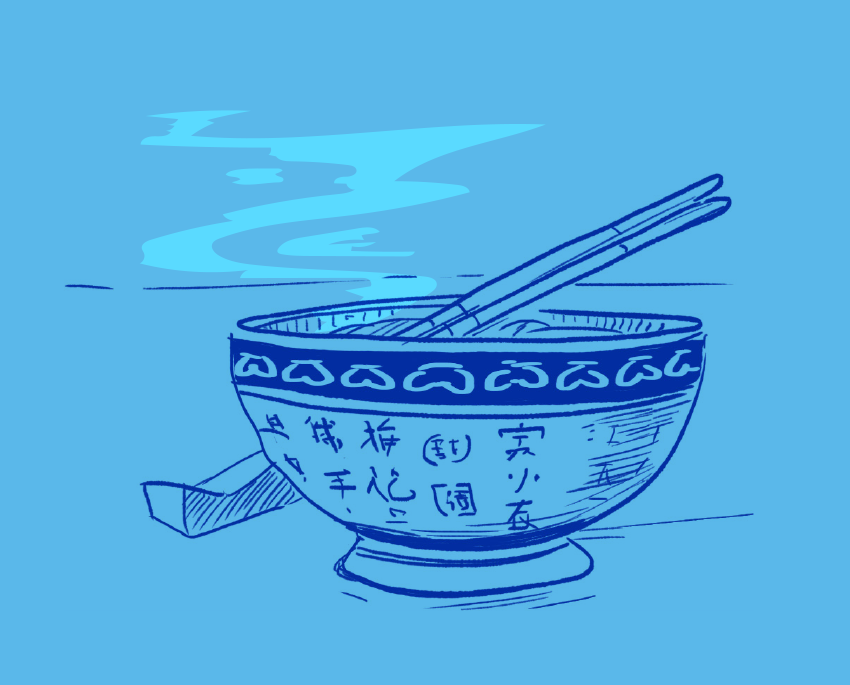
Lunch was followed by relaxation, which might include composing poems or enjoying the garden.
3-7pm
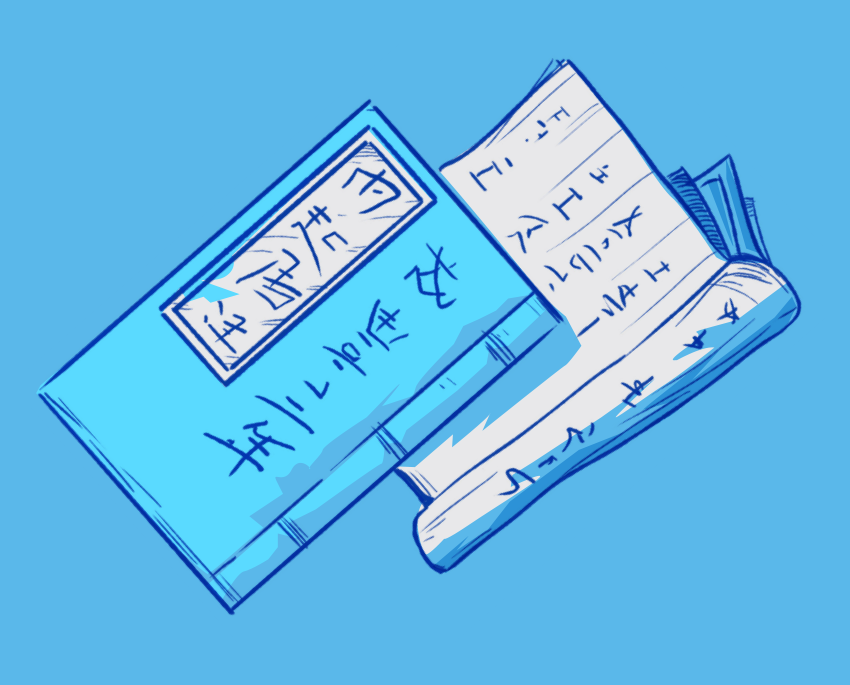
The afternoon was spent reading more memorials. Once signed off in red ink, the papers were returned to the country's administrative divisions via the directorate of ceremonial office.
8pm

The emperor took a light supper. His duties were then considered complete, and he could retire to his chambers.
"No one in any dynasty of China ever lived a more rigidly controlled court life than the emperor of the Ch'ing. Due to strict observance of traditional conventions of the court, the freedom of the emperor was far less than that of an ordinary man."
"As long as the emperor stayed within the court, he was restricted in every way by tradition. Consequently, it was only natural that the emperor wished to stay away from court as much as possible. When the emperor lived in a detached palace, he could lead a comparatively free life, for he was exempted from the early-morning audience, he could dine with his consorts, and every manner and custom was simplified. Nevertheless, he was not as free as an ordinary person, for he still had to give daily audiences and promulgate instructions considering the documents submitted to him … The only amusements the emperor could enjoy in the court were to attend a stage show, to practice calligraphy, and to paint. No other amusements were permitted.”
Su Chung (the name given to Japanese-American Yokiko Toshima, when she married a man whose family had close ties to Emperor Puyi) from her book Court Dishes of China, first published in 1965.
STATE AFFAIRS
Emperors were responsible for conducting the necessary state religious rites to maintain the harmonious balance between heaven and the nation. While the Qing dynasty (1644-1911) inherited most of its administrative institutions from the Ming period, the Qing emperors were autocrats. They ensured their decisions prevailed in all matters of government. Key institutions like the Grand Council, Grand Secretariat, and Political Conference served only as advisers and were strictly forbidden from making high-level decisions themselves.
PLACES
The Palace of Heavenly Purity was established as the primary residence for emperors during the Ming dynasty (1368–1644), a tradition continued by early Qing emperors. This changed when the Yongzheng Emperor (reign 1722–1735) moved his personal home to the Hall of Mental Cultivation, though he continued to use the Palace of Heavenly Purity for state functions.
PALACE OF HEAVENLY PURITY
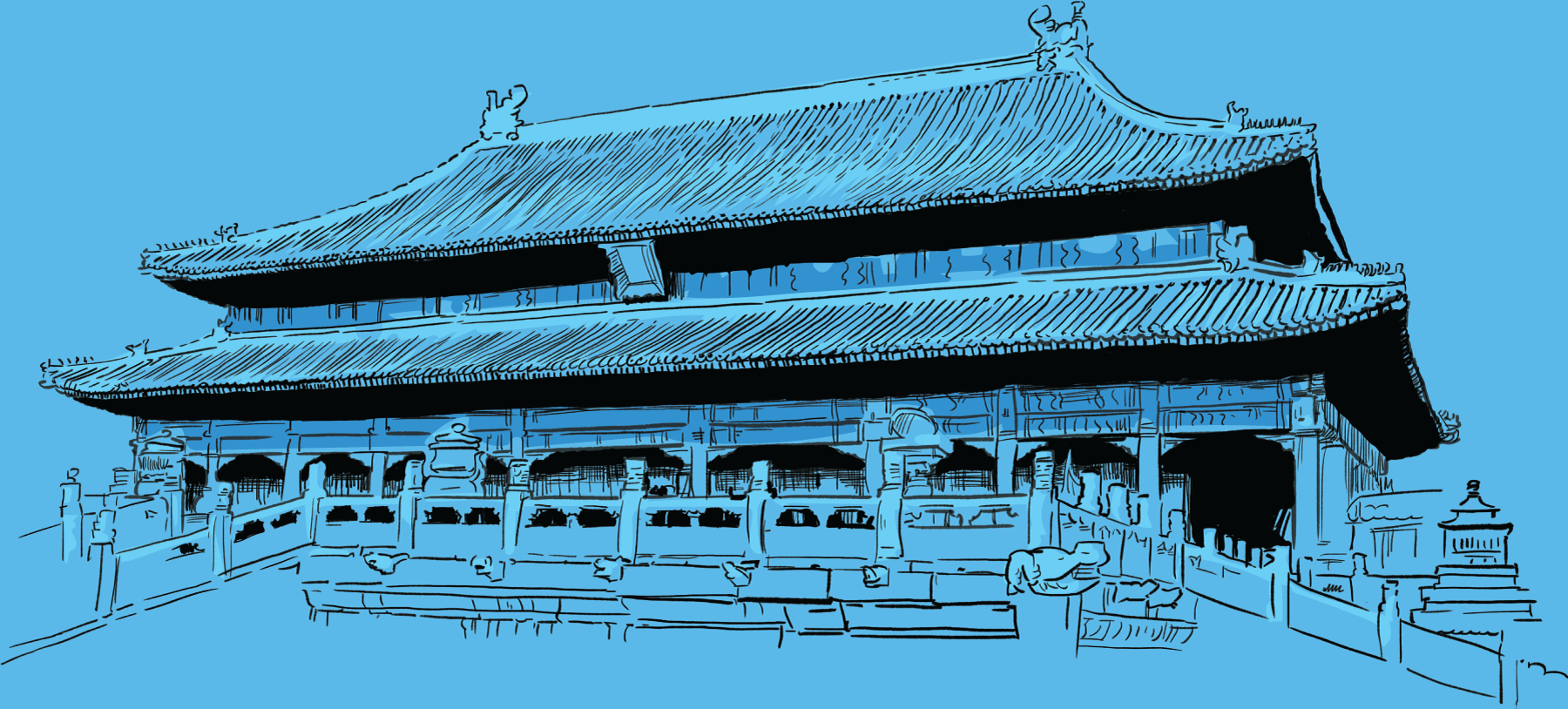
Built in 1420 (and rebuilt in 1798), this palace was the centre of imperial governance. Here, the emperor read and signed state documents, and interviewed ministers and envoys. It was also occasionally used to host banquets and other grand ceremonies.
Following the Yongzheng Emperor, all emperors adopted a system to keep the imperial successor a secret. The emperor would write a secret edict naming a successor from his sons and create two identical copies. One copy was kept by the emperor, and the second was sealed in a box placed behind a horizontal board hanging over the throne.
After the emperor’s death, regent ministers opened both copies of the secret edict to verify the designated prince before announcing the new successor to the court.
THE HALL OF MENTAL CULTIVATION
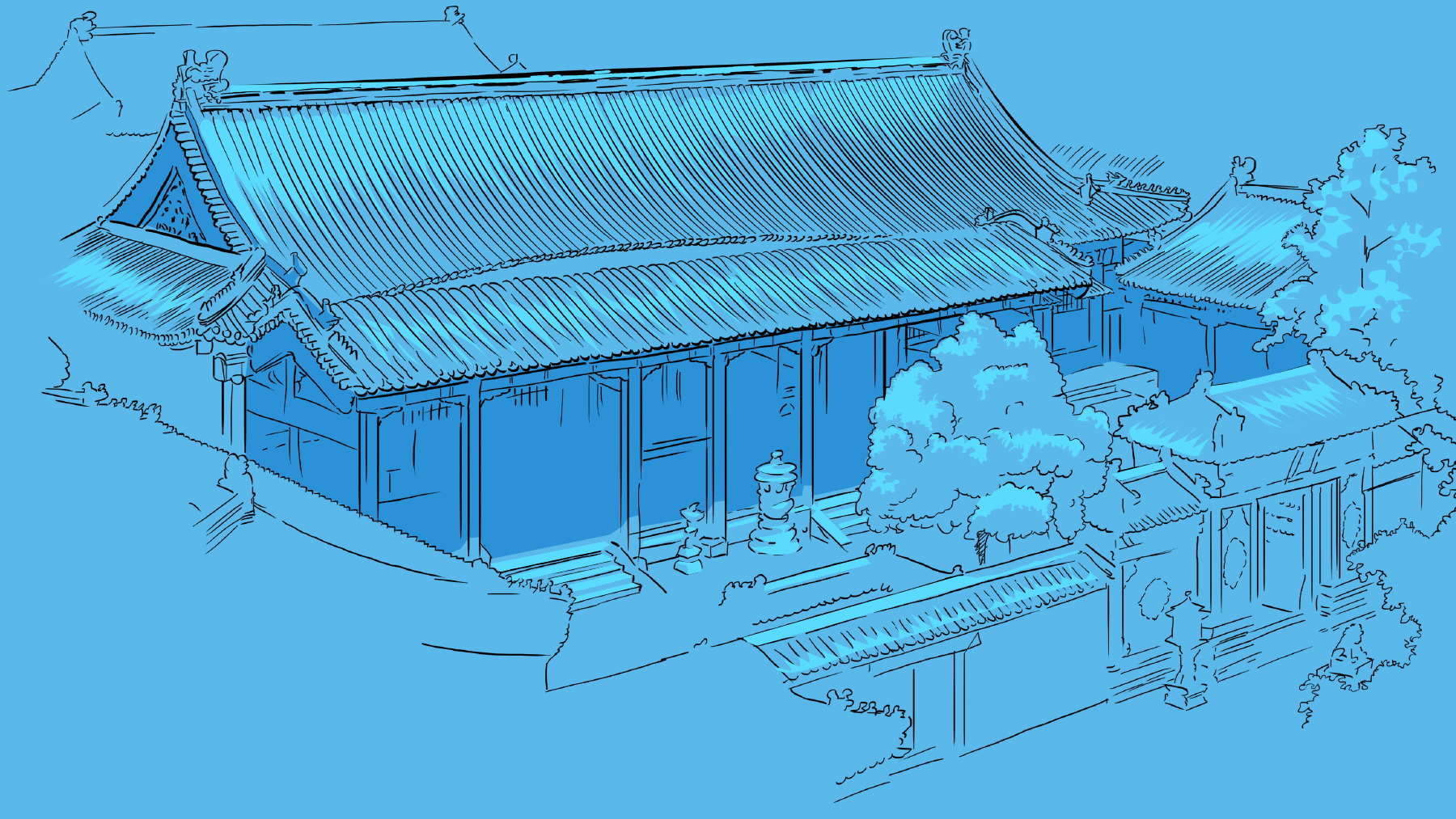
The Hall of Mental Cultivation became the primary location for the routine administrative affairs after the Yongzheng Emperor moved there. It was physically divided into a front and rear section connected by a hallway. The five-chamber rear section served as the emperor’s private living quarters. The front section was administrative: the throne was situated in a central area, and the West Warmth Chamber was used for discussing political affairs. Like all palaces in the inner court, the Hall was designed following the rules of strict symmetry.
KNOCKING THE TILES
The floor tiles of the Hall featured inverted mud jars underneath to create a unique echo or resonance when struck. Ministers granted an audience would mention their ancestors while kowtowing (the act of kneeling and bowing so low as to touch the ground with the forehead). The louder, more resonant sounds produced by striking tiles were considered a sign of great respect for the emperor. This ritual became corrupt, as eunuchs in charge of the Hall would indicate the places with the best resonance in exchange for a bribe. Guests found it nearly impossible to produce a noticeable sound, no matter how hard they struck the floor, without first greasing a eunuch’s palm.
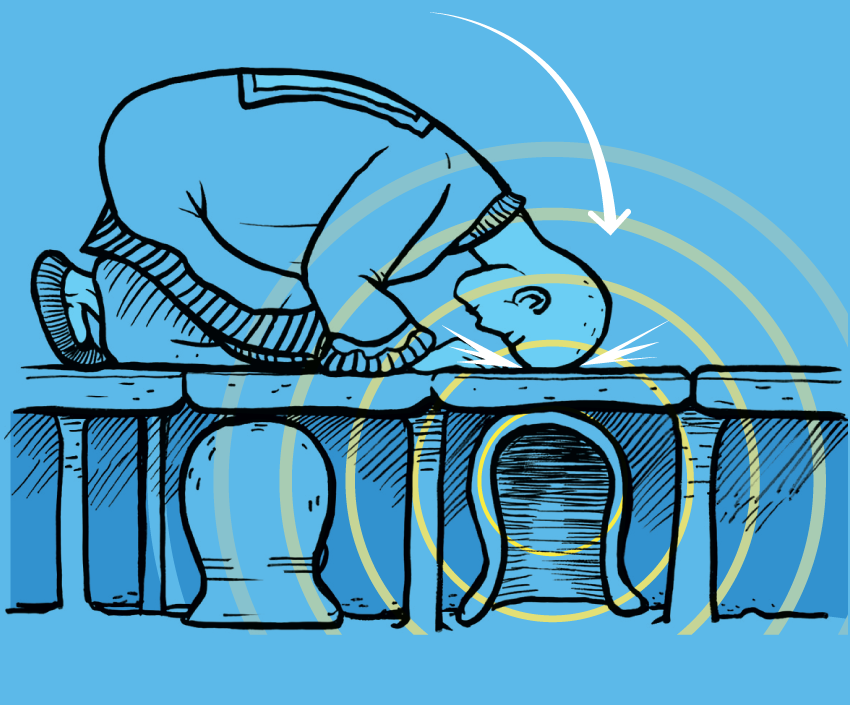
BED CHAMBER
Due to strict security protocols, the emperor rarely slept in the same room on consecutive nights, ensuring his precise whereabouts remained secret.
OBJECTS
Feeding his majesty
Another common misconception is that the emperor routinely feasted on lavish meals. His diet was balanced, but surprisingly plain, reflecting the principle of both the Ming and Qing dynasties that diet must promote health.
The infrastructure required to provide food was immense. The imperial kitchen was composed of three parts: the main kitchen, the tea kitchen and the bakery. Each section had a chef, five cooks, a supervisor, and an accountant responsible for procuring and tracking supplies.
Menus always carried the cook’s name so that popular dishes could be reordered and, crucially, culprits could be identified if anything suspicious occurred. Imperial recipes were essentially sophisticated versions of meals traditionally enjoyed by the common people.
SERVING MEALS AND PALACE CUSTOMS
Qing emperors primarily ate their meals alone, except during special ceremonies; even family members were usually excluded. Although the Qianlong Emperor sometimes invited a consort, protocol dictated that all people, except a dowager empress, had to stand in the emperor’s presence. The empress and imperial concubines always took their meals separately in their places.
The emperor's diet typically consisted of pork, mutton, game, fowl and vegetables. Beef was banned in the palace because consuming beasts of burden was considered a sin. All dishes were served with covers that were removed only when the emperor took his seat.
Menus for each meal were drawn up in advance, submitted to inner court officials for approval, and meticulously archived.
THE TABLE SET
The serving display included enamel bowls, plates and dishes, blue-and-white jade sunflower tureens, and gold- and silver-thread embroidered napkins.
Qing dynasty emperors generally had two formal meals per day. Meals were served on gold dishes or fine Jingdezhen porcelain. A significant shift in customs occurred during the Qing era: the emperor had no fixed place or time for meals. He simply informed his guards when he wished to eat, and kitchen officials immediately ordered eunuchs to set a table wherever the emperor happened to be at that moment.
THE IMPERIAL KITCHEN
Located just west of the Hall of Supreme Harmony, the Imperial Kitchen required a massive staff. Its administration included a director, deputy and assistant directors, a manager, an executive manager, and clerks. In total, more than 200 officials, cooks, and eunuchs were employed solely to handle the emperor's daily meals, which were always prepared separately from everyone else’s.
POISONING FEARS
HEALTHY HABITS
The Imperial Kitchen adjusted the emperor’s diet according to the season. Lighter dishes were served in the summer. Conversely, heavier, more filling meals were prepared in winter, as they were believed to create more vital energy.
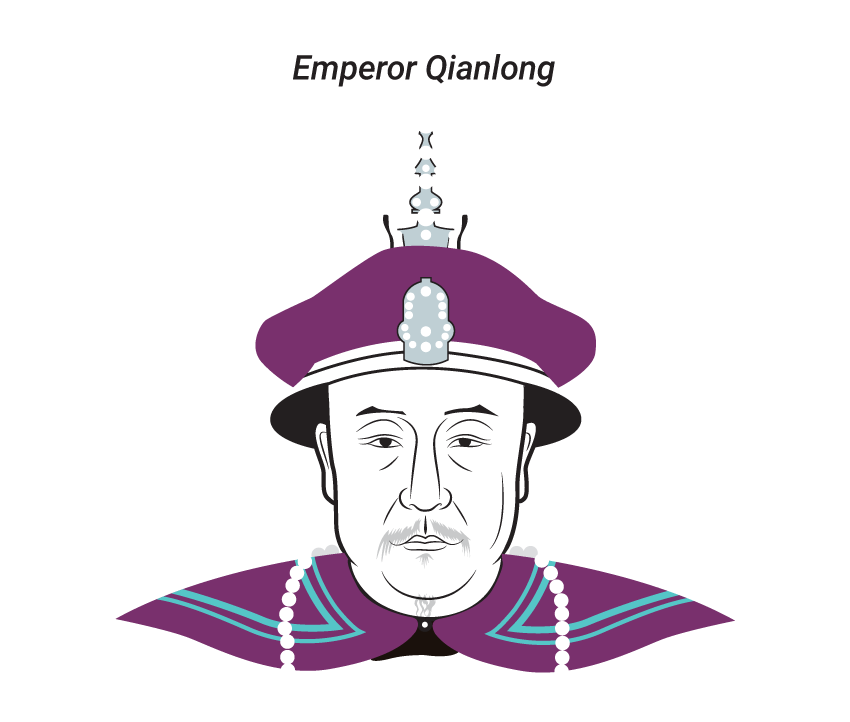
Qianlong Emperor’s breakfast: served one morning in the Yihong Hall (Hall of Partial Rainbow), the meal included:
Qianlong Emperor’s dinner: served one night in the eastern room of the Yangxin Hall (Hall of Mental Cultivation), the meal included:
SOURCES OF FOOD SUPPLIES
All ingredients for the emperor’s meals were supplied by the Palace Food Directorate and the Imperial Kitchen, which maintained a rigorous system for an uninterrupted food supply. Dozens of eunuchs managed palace subsidiaries to ensure fresh ingredients. These operations included farms supplying lamb, geese, chickens and ducks, as well as the imperial mill and vegetable garden; eunuchs also ran the wine office, which produced fermented soy wine. Much of the high-end produce came in the form of tributes from distant regions, delivered by iced barges along the Grand Canal.
The Qianlong Emperor commonly took his tea with milk; accordingly, herds of cattle were maintained, with 100 cows kept in reserve solely to provide his milk supply. Water from the springs of Yuquan Shan was used exclusively for cooking and making tea.
REGIONAL SPECIALTIES SENT TO THE PALACE
MEDICINAL FOOD AND IMPERIAL HEALTHCARE
Qing dynasty emperors regularly consumed foods with medicinal properties. Numerous palace archives record the use of items like wines, juices, extracts, preserved fruits and sugar specifically for health benefits. These items were believed to perform vital functions, including stimulating the stomach, kidneys, and appetite; reducing internal heat and phlegm; nourishing the body; and prolonging life.
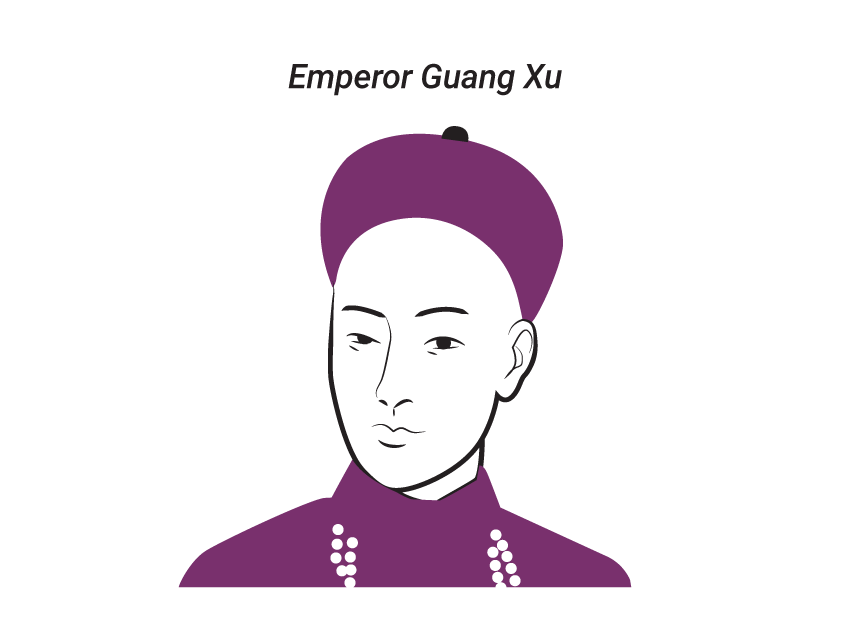
The emperor’s medical treatment was highly regimented. For example, the Guangxu Emperor (reign 1875–1908) had an infirmary staff of nearly 100 personnel, including 30 doctors.
Dress codes
Garments have always reflected a culture’s social and historical evolution. Imperial Chinese rulers imposed strict dress codes for every era, often linked to their own ethnic traditions and identity. These rules stipulated the required material, colour, decorative patterns, and style to distinguish the royal family, civil officials, and military officials from commoners. Defying the dress code was severely punished. For example, Ming rulers (1368-1644) forbade the Mongol attire of the previous dynasty, while the succeeding Qing dynasty (1644-1911) imposed drastic changes reflecting their Manchurian origins, which met with strong resistance from the Han majority.
MING DYNASTY ATTIRE (1368-1644)
The attire of the Ming dynasty, the last ruled by the ethnic Han, was characterised by a loose-fitting and elaborate style. Clothing for both men and women became voluminous, featuring broad sleeves and long robes. This was the last dynasty in which men wore a skirt. Buttons and circular collars became popular, and jackets grew longer. Most garments were made of silk, with light colours favoured in the early era. Garments were often elaborate, featuring inlaid black brims and cyan collars, and were decorated with accessories made from gold, jade and pearls.
The great prosperity of the Ming period, which lasted nearly three centuries, fueled the expansive production of these elaborate goods and garment styles.
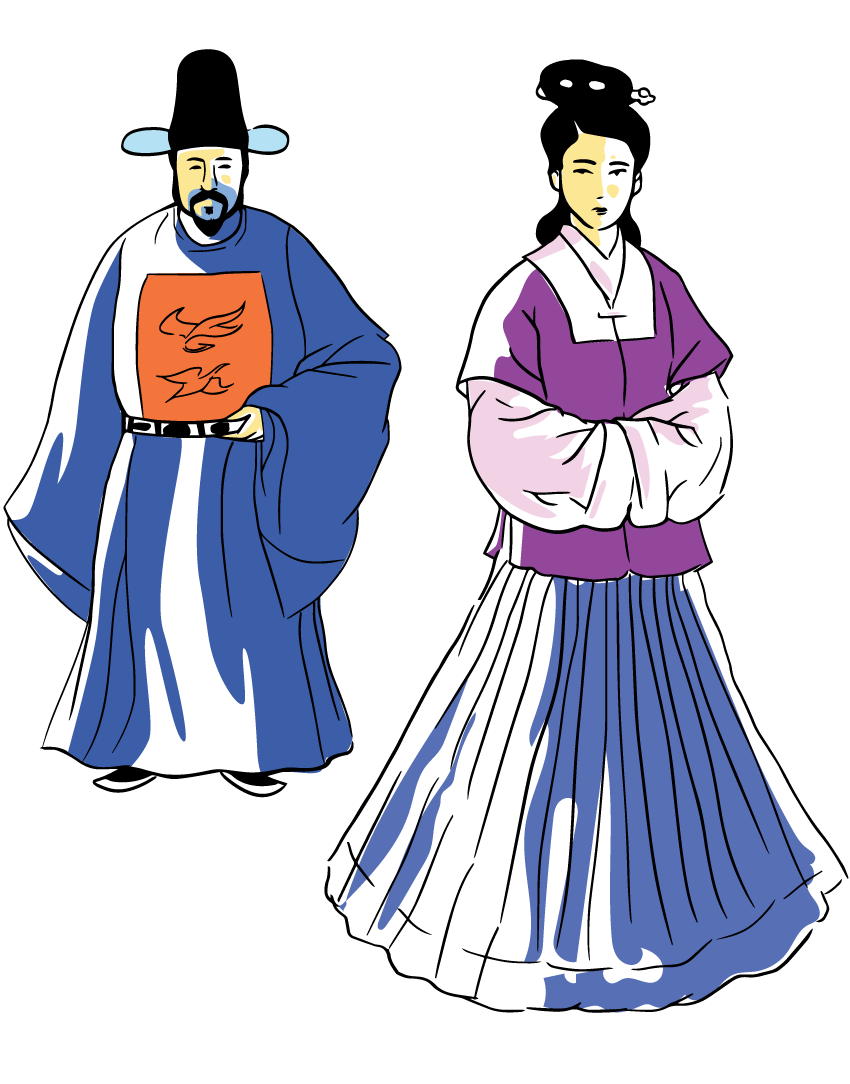
CIVIL AND MILITARY FEATURES
Symbols of rank and office were mandatory in China since the Tang dynasty (618-907), when the first (and only) female ruler, Empress Wu Zetian, ordered officials to wear embroidered gowns. The Ming dynasty continued this powerful tradition, distinguishing the type and rank of officials with buzi - embroidered cloth patches - attached to the chest and back of their gowns.
Buzi 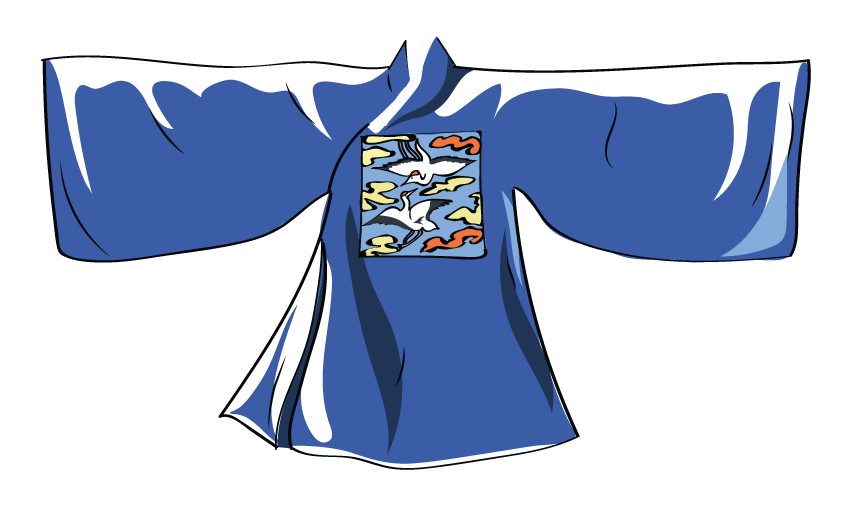
These striking patches vividly expressed the relationship between clothing and power, depicting all manner of real and mythical creatures. The buzi signified nine distinct ranks for both civil and military officials. Civil officials wore patches featuring birds (such as cranes, golden pheasants and peacocks). The crane, for example, was an important symbol of longevity due to its long lifespan and white feathers signifying old age. Military officials wore patches decorated with fierce beasts (such as tigers, lions and panthers) to signify their rank.
Civil officials samples
QING DYNASTY ATTIRE (1644–1911)
Clothing played a vital part in the political life of the Qing emperors, as the dress code within the palace signaled political hierarchies and ensured the observance of ancestral Manchu traditions.
During the Chongde period (1636–1643), adherence to the dress code was considered fundamentally important to the stability of the country. Hong Taiji, the founding emperor of the Qing dynasty, strongly emphasised martial skills, famously stating that horsemanship and archery were the “two basic skills” of China. Consequently, official attire, particularly for riders and archers, featured tighter-fitting suits that contrasted sharply with the voluminous robes of the previous Han-ruled Ming dynasty.
THE DRAGON ROBE
The emperor’s most remarkable attire, in terms of ornamentation and symbolism, was the dragon robe - an auspicious garment reserved for festive occasions. This robe was not just meant to signify the emperor’s power, but also to bring good luck to the people. Qing dynasty imperial robes lent legitimacy to the proverb that the reign of every emperor begins when he dons his new robes.
The creation of a single dragon robe was an immense, multi-stage project that required more than two years to complete. The patterns and cuts were developed in a dedicated palace tailoring shop, subject to approval from the emperor and the highest-ranking officials. The approved patterns were then sent to silk manufacturers. Once the fabric was ready, an artisan cut it before the tailors began the elaborate embroidery. The process involved the finest threads, including some made from gold. The stitching required the contribution of hundreds of artisans, with dozens required just for the gold embroidery.
The robe is tight fitting with sleeves tapering into flared cuffs that resemble the hoofs of a horse – a reference to the Manchu equestrian background.

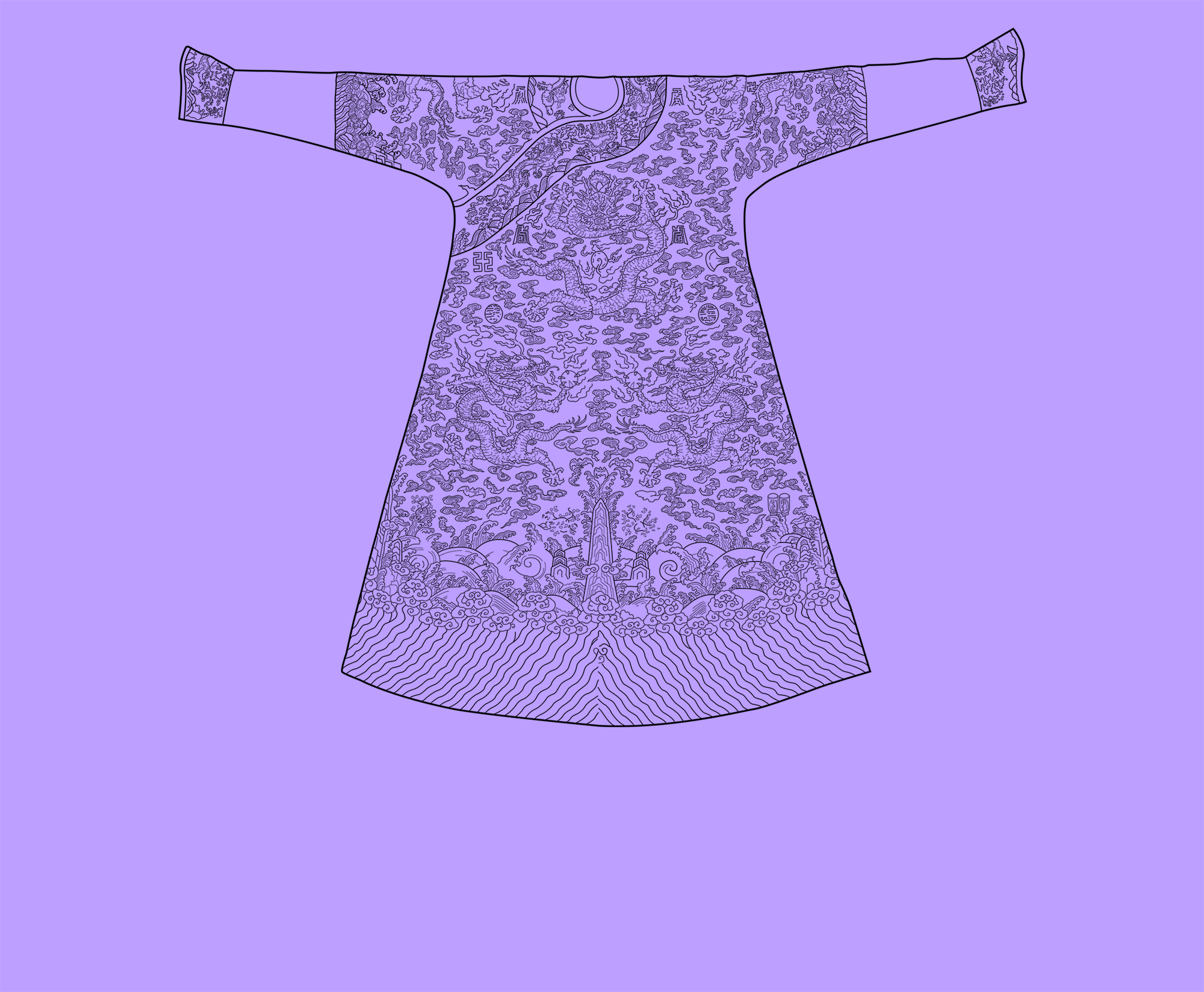
A dragon is the dominant motif, with four dragons surrounding the neck symbolising the main directions of the universe, and four on the front and back of the skirt indicating the midway directions of the universe.
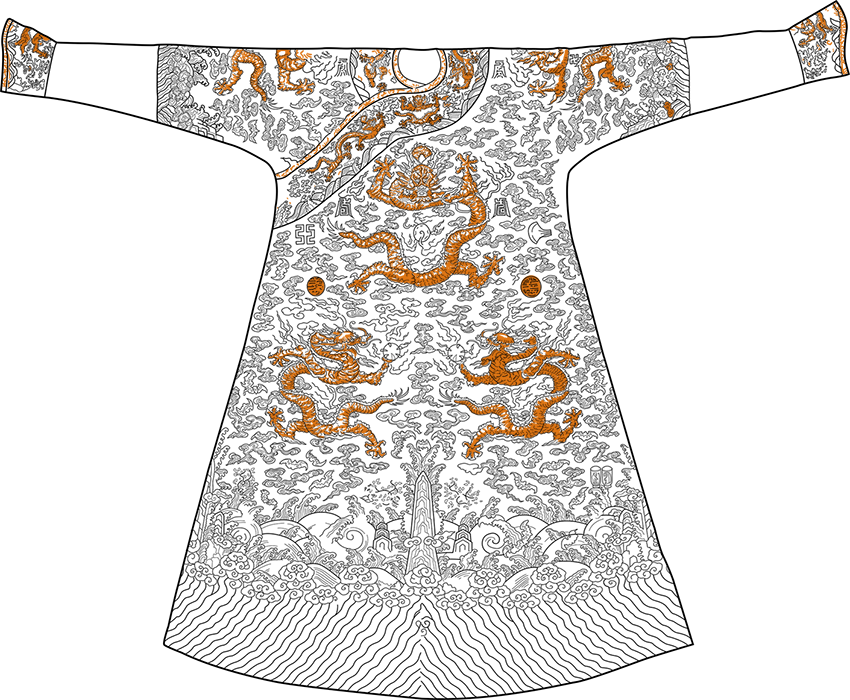
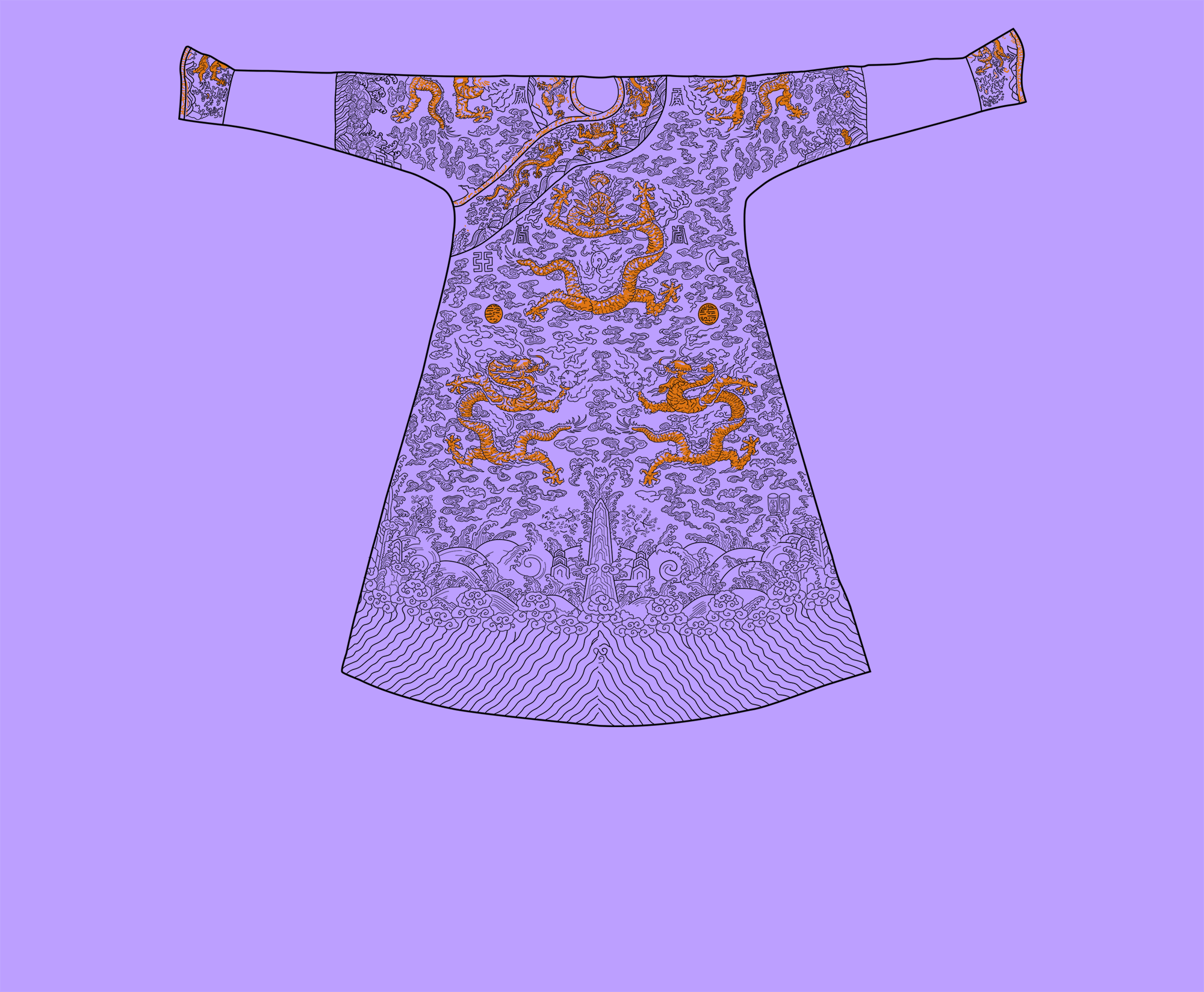
Another motif applied to the emperor’s robes was a red bat, the symbol of happiness. The Chinese word for bat sounds identical to the word for good fortune
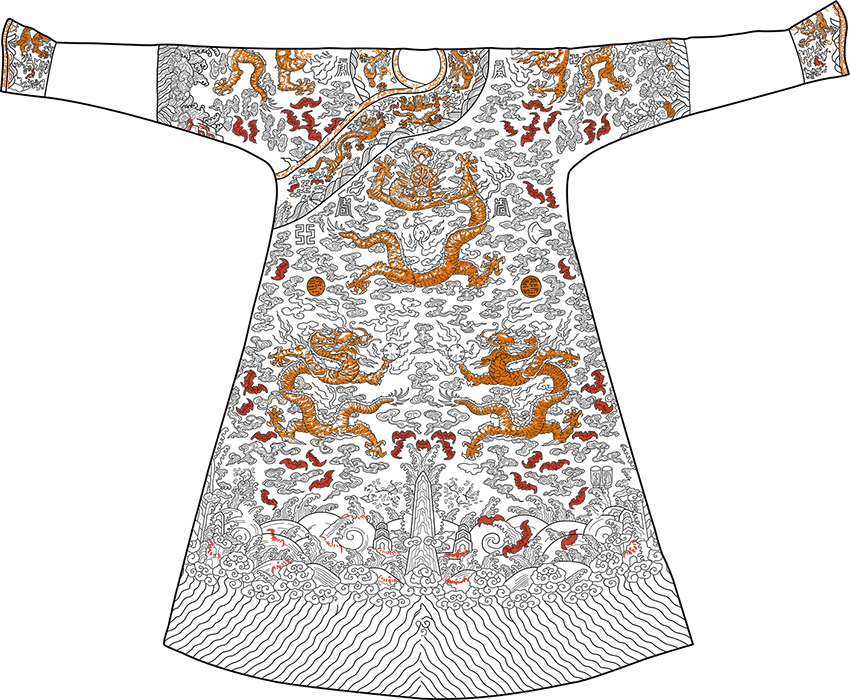
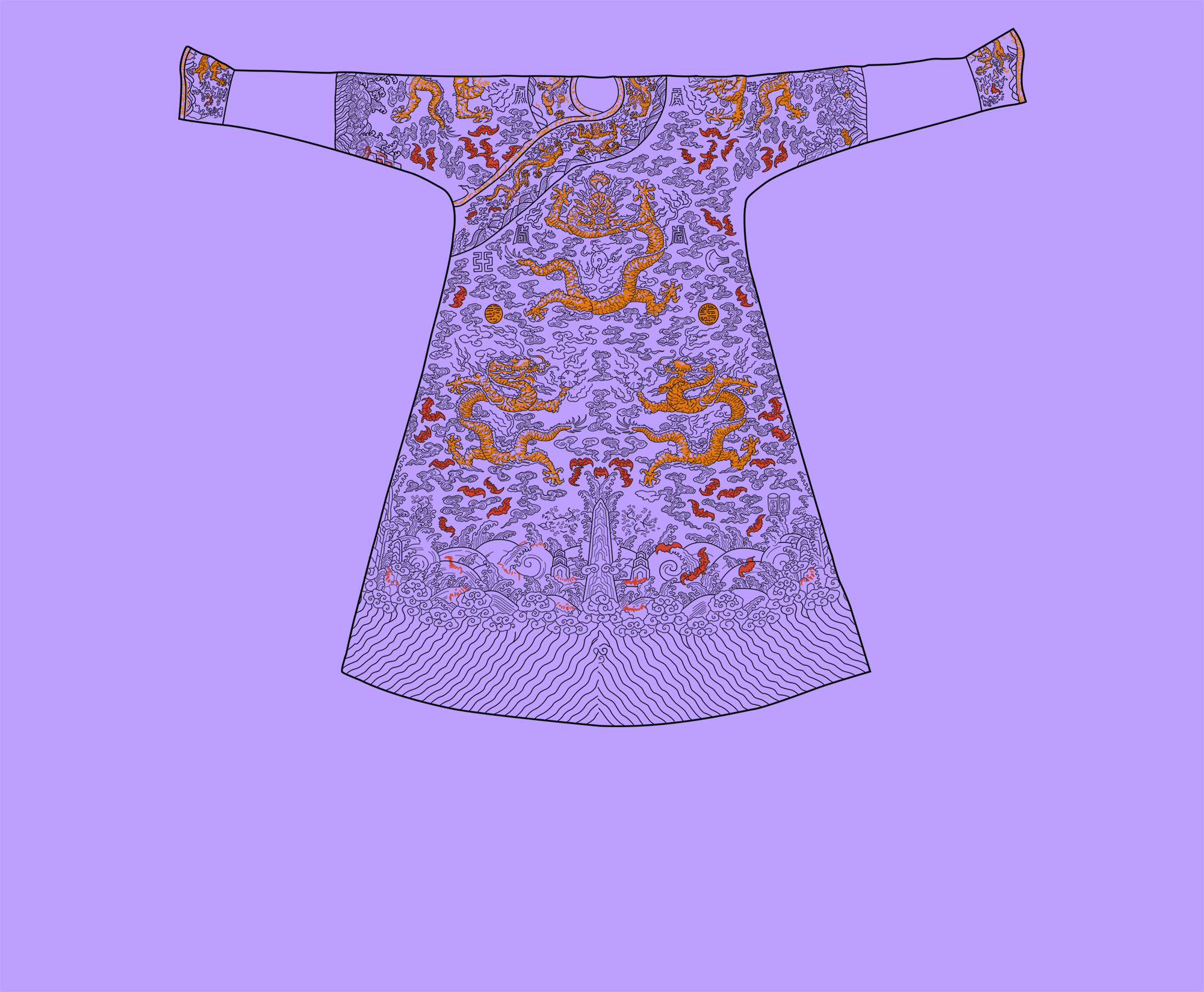
The robe included a series of symbols, such as large dragons on the chest and back and small dragons on the shoulders and skirt. Apart from auspicious symbols, the dress featured mountains and waves.
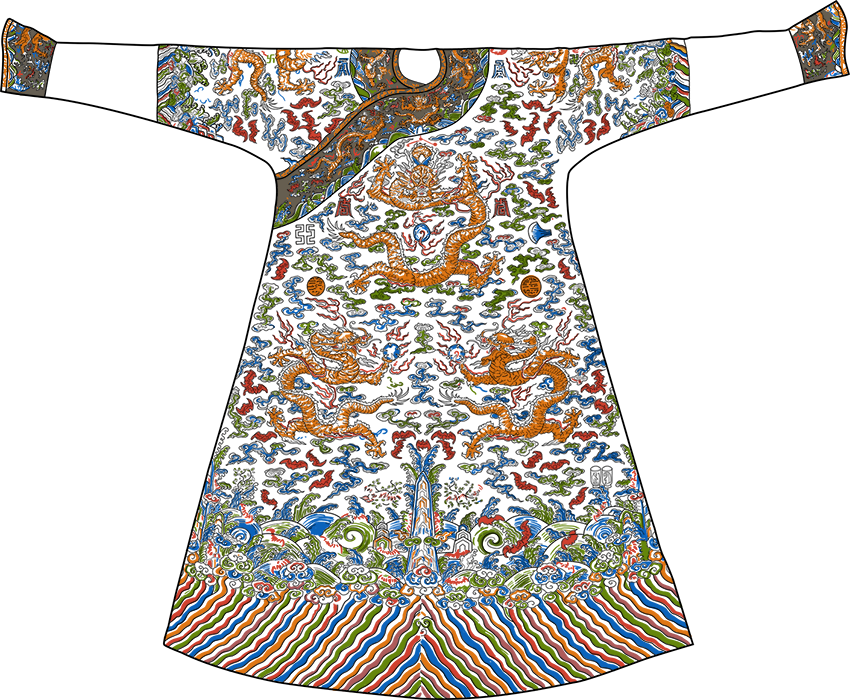
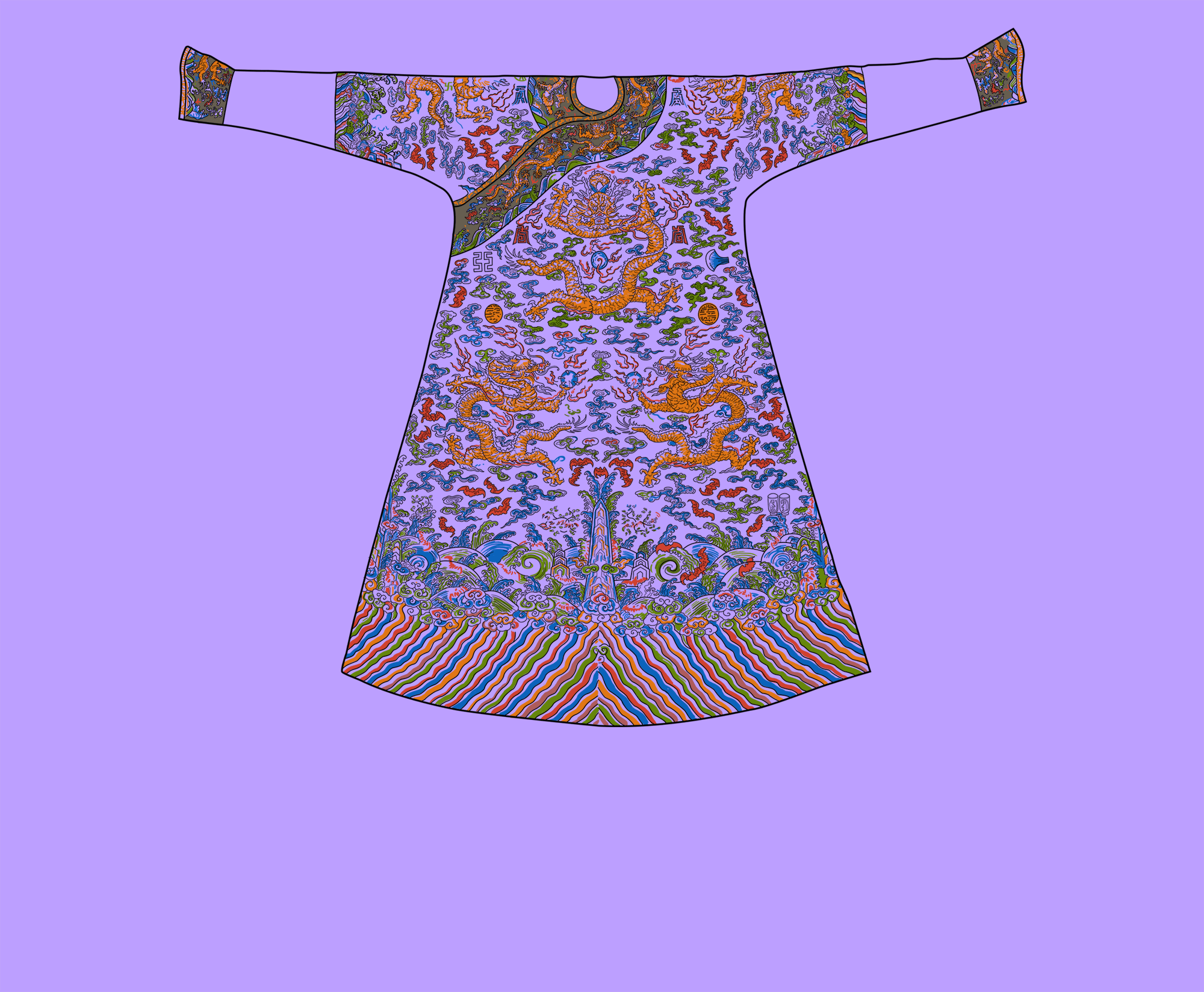
The colour at the bottom of the robe indicated rank and lineage, with yellow restricted to the emperor.
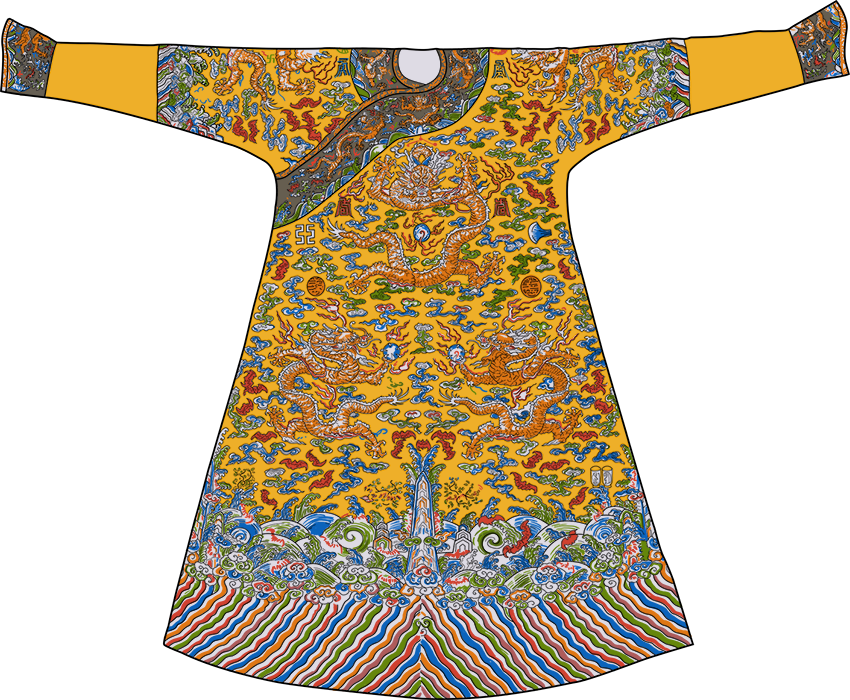

COSMIC SYMBOLISM OF THE EMPEROR’S ROBE
“The lower border of diagonal bands and rounded billows represents water; at the four axis of the coat, the cardinal points, rise prism-shaped rocks symbolising the earth mountain. Above is the cloud-filled firmament against which dragons, the symbols of imperial authority, coil and twist. The symbolism is complete only when the coat is worn. The human body becomes the world axis; the neck opening, the gate of heaven or apex of the universe, separates the material world of the coat from the realm of the spiritual represented by the wearer’s head”.
– John E. Vollmer, curator and scholar of Asian art, textiles, costumes and design. He is the author of 30 museum exhibition catalogues and multiple books and articles.
FURTHER READING
We invite you to explore other chapters of this special Post presentation for a glimpse into a unique part of Chinese history.
RELATED STORIES
China’s first emperor really did send quest to Tibet in search of immortality: scientists
Did China’s first emperor send expedition west in quest for ‘elixir of life’?
Why were Chinese emperors’ names taboo? Like popes, their titles reflected their legacy
What China’s shift from feudal to imperial system tells us about today’s political climate
These 3 individuals shaped ancient Chinese history during their childhood
The Palace Museum
By South China Morning Post graphics team
-
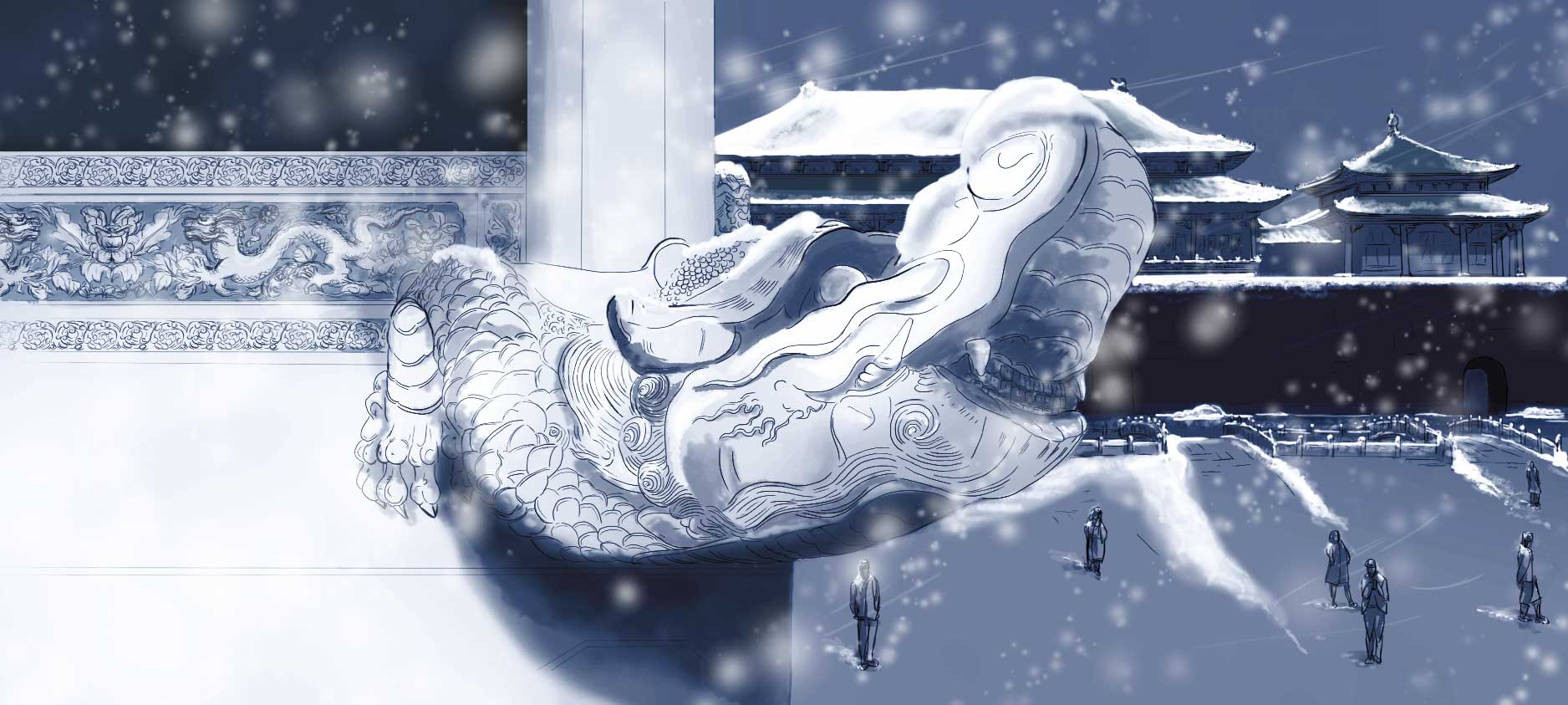
I
PARTThe Forbidden City’s unique architecture
By Marco Hernandez
-
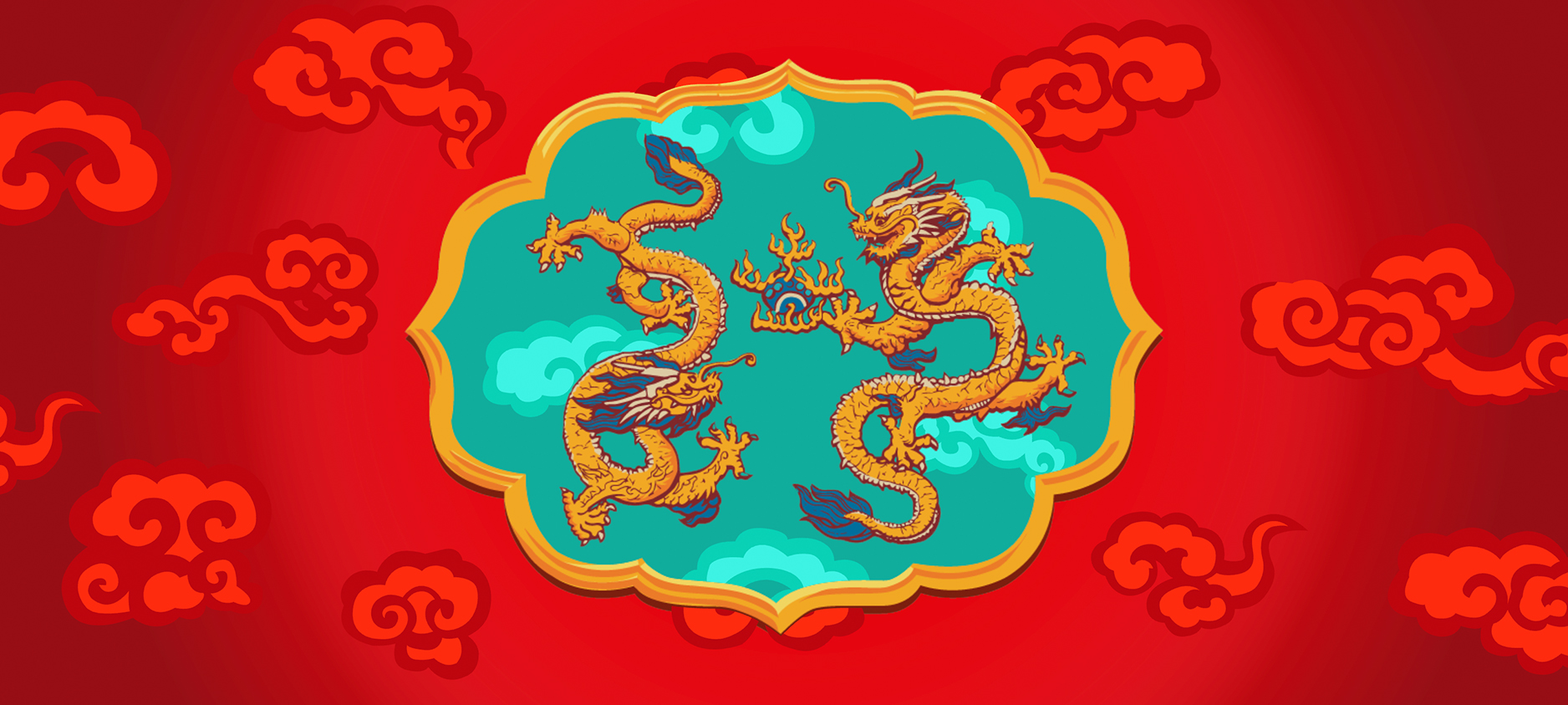
II
PARTLife inside the Forbidden City
By Marcelo Duhalde
-

III
PARTThe collection, the odyssey of the objects
By Adolfo Arranz
